In early 1891 a Civil War veteran named Colonel Levi C. Brinton (1842-1927) purchased about seventy-one acres of rural property along Big Run in Shenango Township, Lawrence County, Pennsylvania. The scenic property that Brinton purchased contained a picnic grove known as Big Run Park (sometimes referred to as Sylvan Park) and located outside the city limits of New Castle. It was located along the New Castle-Ellwood Road (later East Washington Street) and at the time it was surrounded by sprawling farmlands.
Brinton, of Quaker heritage, was born in Westmoreland County, Pennsylvania. During the Civil War he saw service with the Union Army as an artillery officer at such battles as Bull Run (2nd), Antietam, Fredericksburg, Gettysburg, and Cold Harbor. He spent time in Braddock before relocating to New Castle in the late 1880’s. He acquired several properties in Lawrence County, including at Big Run.
He had a dream to build Big Run Park, centered alongside a deep ravine that contained Big Run creek, into a first class summer resort. He added an outdoor dancing platform and enlarged the picnic grove. To get patrons to the rural site, which he renamed as Brinton Park, he decided to build a streetcar line up Hamilton Street and into New Castle. The Brinton Park Street Railway Company, headed by Brinton and several minor partners, was given approval by city officials in May 1893 to begin construction. In August 1893, perhaps due to a legal maneuvering of some sort, Brinton transferred ownership of various land holdings to his wife Anna.
Work on the streetcar line was in full swing in early 1894. Brinton envisioned big things for the property and the New Castle News of Wednesday, June 6, 1894, reported, “Levi Brinton, manager of Brinton Park, has made arrangements with a New York firm for the construction of a mammoth roller coaster at the park. Work will begin at once and will be hurried as rapidly as possible. Brinton Park is fast becoming a famous picnic ground. Manager Brinton has several picnics booked for this season, and as soon as the street car track is completed, which will be not later than June 15th, he expects to book a great many more.”
Various internal squabbles regarding finances halted work on the streetcar line in the summer of 1894. A back and forth legal battle ensued and the unfinished streetcar line was seized by the county sheriff later that year. The New Castle Electric Street Railway Company, which provided streetcar service within the limits of New Castle since 1890, made several unsuccessful attempts to acquire the line. All the while the Brinton Park streetcar line sat uncompleted. It appears the internal issues were finally resolved in May 1896, which cleared the way for the streetcar line to be sold. Brinton’s dream was beginning to crumble.
The New Castle Street Railway Company, under a new ownership syndicate from Pittsburgh, was finally able to acquire the long-stalled Brinton Park Street Railway Company by early June 1896. The ambitious company also acquired the New Castle Electric Light Company. The streetcar lines and associated electric company were all consolidated under the newly established New Castle Traction Company.
The new streetcar syndicate unsuccessfully attempted to purchase the entire Brinton Park property from Brinton. The New Castle News of Wednesday, August 12, 1896, mentioned, “Levi C. Brinton says that he is not a bit disappointed because the street car company did not buy his park. He claims that the new company was only willing to pay him $15,000 for the property and as he considered it worth a great deal more than that he prefers to hold it. He claims that he will have a way to take people to the park next summer.”
They continued to negotiate but things often got nasty. It was an odd situation as the streetcar company owned the actual rails of the old Brinton line, but it was on property still owned by Levi Brinton. On Friday, August 7, 1896, Brinton witnessed a team of eighty workers tearing up the streetcar track on his property. The veteran soldier thought about threatening them with a revolver, but instead sought the assistance of the local authorities.
Several newspaper articles do not support the rumors that Brinton was ready to step away from the whole venture in early 1897. The New Castle News of Wednesday, February 24, 1897, reported, “Levi C. Brinton has rented his farm in Perry township to George Graft. The latter will take possession at once. Mr. Brinton will devote his attention to Brinton park next summer. He proposes to make the park one of the most attractive spots in Western Pennsylvania. It is probable that a hack will be kept at the termination of the street car line near the Almira Home and passengers will be conveyed from there to the park at a trifling cost. Among the improvements which Mr. Brinton has in view is a hotel.”
A month later Brinton apparently decided against continuing as he sold the entire property for $16,000. The New Castle News of Wednesday, March 24, 1897, mentioned, “It is reported that Brinton Park was sold to the New Castle Street Car company Saturday. Mr. (DeWitt) Dilworth of the company, was seen about the reported sale, but had no further particulars to give for a few days.” A few years later, in September 1901, the company was able to acquire an additional five acres of adjoining property from the Buffalo, Pittsburgh, and Rochester Railroad (BP&R) to increase the park to about seventy-six acres.
The New Castle Traction Company soon took over possession of Brinton Park and called in well-known civil engineer and landscaping architect Frank Blaisdell of Boston, Massachusetts, to beautify the property. They wasted no time in building it up with a large dancing pavilion, an outdoor amphitheater, and several amusement rides including a carousel. Other attractions included refreshment stands, a small zoological park, several picnic groves, a baseball field, and a fifteen-acre lake. The lake was stocked in the coming years and became a popular fishing spot.
The park was managed by personnel from the New Castle Traction Company. There was often a park superintendent, park manager, and booking (or excursion) agent. Frank C. McGonigle, a senior electrician with the Traction Company, served as the first superintendent of Cascade Park.
The Traction Company lobbied for approval to open a streetcar extension to the park via Hamilton Street and Cascade Boulevard – essentially to complete the old Brinton line. The city council approved the venture in late March 1897 and work began almost immediately. A main entrance to the park was established at the terminus of the streetcar line along Cascade Boulevard, while another was opened along the New Castle-Ellwood Road.
The expedited work to complete the streetcar line to the park resulted in tragedy. While working on “the cut,” the deep right-of-way being dug through the hills along modern-day Hamilton Street, a massive cave-in on Saturday, May 15, 1897, resulted in the death of two immigrant workers and injury to several others. Work resumed and the intense project was completed by the end of the month.
Streetcars brought people from all over western Pennsylvania and eastern Ohio to Cascade Park. It was another of the so-called “Trolley Parks,” the turn-of-the-century precursor to the modern amusement park. Trolley Parks were operated by the streetcar lines as a way to drum up trolley business on the off-peak weekends and – in some cases – to show off their associated electric services with the various lighted rides and displays. Several railroads provided additional service to stations near the park. Years later, in the summer of 1908, the Harmony Short Line, a new interurban streetcar running from Pittsburgh to New Castle, opened a station just east of the park.
A public contest, which included a $10 prize, was held to officially name the new park. The winning entry, submitted by eight-year-old Edwina Norris of #102 Grant Avenue, New Castle, dubbed the property with the name it still bears today: Cascade Park. Edwina, the daughter of Edwin F. Norris, the superintendent of the Lawrence Glass Works, came up with the idea due to the “cascading” water over the falls within the park. (NOTE: Edwina Norris later attended the National Park Seminary in Maryland, married Henry Rappold in 1924, and became a longtime kindergarten teacher. She eventually retired to Key West, Florida, where she died at the age of eighty-one in March 1970. She is buried in Oak Park Cemetery in New Castle.)
Cascade Park officially opened on the afternoon of Saturday, May 29, 1897, and was well-received by the public. Edwina Norris and her family were honored guests that day. The New Castle News of Wednesday, June 2, 1897, carried a lengthy article that announced, “Cascade Park, the most beautiful pleasure resort in Western Pennsylvania, was thrown open to the public Saturday. Notice of the changes being made since the grounds were purchased by the New Castle Traction company have from time to time been chronicled in the newspaper, but the thousands who attended the opening were totally unprepared for the wonderful transformations. The company has spared no expense in beautifying the grounds, and they are today unsurpassed for beauty of natural scenery and artistic embellishments.”
The same article went on to mention, “Just north of the falls and upon a nice elevation the dancing pavilion has been built. It is 70×152 feet with a 15 foot promenade, and portable music stand from which concerts will be given each week. The grounds are lighted by 45 arc lights and many incandescent lights. On Saturday night a grand display of fireworks attracted an immense throng. The fireworks were undoubtedly the grandest ever and embraced many features in the line of pyrotechnics never before witnessed.”
Cascade Park quickly became the favored location for local fireworks demonstrations. Italian immigrant Leopoldo “Paul” Fazzoni, the first man to set up a fireworks operation in New Castle, is known to have set up several displays of fireworks at the park during the summer of 1897. The first ever Fourth of July fireworks display at Cascade Park was postponed due to rain, but were held three days later. The New Castle News of Thursday, July 8, 1897, reported on that fireworks display with, “Big crowds have become common at Cascade park, but that which assembled on Wednesday evening to witness the gorgeous display of fireworks was simply tremendous. It is estimated that fully 9,000 people saw the display, and of this number it would be impossible to find one who did not feel that the sight was well worth the trip. The display began at 9:30 and as the first rocket shot skyward and exploded, the falling sparks illuminated a sea of upturned faces which in itself was a sight well worth seeing.”
The New Castle News of Wednesday, September 29, 1897, reprinted a small article that originally appeared in the Youngstown Vindicator. It read, “Cascade park in itself is an attraction worth thousands of miles of travel to see and admire. It is a veritable garden of Eden in beauty with true zoological collections, dense forest and noble trees, mighty waters dashing over the rocks and ledges, the spray silvering the surrounding turns and mosses. There is also a dancing pavilion, the largest in the Keystone state, provided with every comfort and courtesy and the best of music.”
Major improvements continued over the next few years. A large grandstand was added to the baseball field in 1898 and this site quickly replaced the old athletic grounds on South Mill Street (and East Division Street) as the premier baseball field in New Castle. In 1898 the diamond was home to a local squad playing in the semi-pro Interstate League, comprised of eight teams from Pennsylvania, Ohio, West Virginia, and Indiana. In 1906 the field began hosting games of the semi-pro Ohio & Pennsylvania League and the amateur New Castle City League. The field is also where the New Castle High School football team played many of its games until Franklin Field (later Taggart Stadium) opened in 1923.
In March 1900 the Traction Company reorganized its executive structure and McGonigle became superintendent of the New Castle Electric Light Company, although he soon left that post to operate an undertaking business in New Castle. An article in the New Castle News of March 28, 1900, mentioned his successor with, “Perry Barge, Superintendent park and ball grounds, care of buildings and grounds, care of privileges, care of attractions, care of amusements.” Perry Barge, a carpenter by trade, wore the uniform of a streetcar conductor and became known for making his rounds about the park on horseback.
In early 1903 a roller coaster, referred to as the Figure Eight and built by the famous Ingersoll Construction Company of Pittsburgh, was erected in time for the opening of the summer season. The outdoor amphitheater was greatly enlarged and soon played host to various comedic plays, vaudeville shows, musical concerts, boxing matches, and Sunday religious services.
The New Castle News of Wednesday, February 11, 1903, reported on these developments with, “The $16,000 roller coaster will be another new attraction at New Castle’s only summer pleasure resort. This has been erected in the ravine just west of the pavilion… The coaster has 1,700 feet of track and the start of the lighting-like journey begins 40 feet above the ground. The fare will be five cents, or six trips for a quarter, although the traction company steadfastly refuses to sell tickets at that rate for regular trips on the street cars. Unfortunately the round trip fare to the park, including admission to the grounds, will remain at 15 cents during the coming season. The park theatre is being enlarged and will afford from 700 to 800 more reserved seats than formerly. The stage will be covered and is being shifted somewhat in position and will hereafter face more toward the carousel.”
In May 1902 the New Castle Traction Company and its associated electric and gas companies were acquired by the Pennsylvania & Mahoning Valley Railway company, which operated a wide-ranging streetcar system based out of Youngstown. Another major reorganization took place a few years later in 1905 and led to the creation of the Mahoning & Shenango Valley Railway & Light Company. This powerful corporation, based in Youngstown, controlled a streetcar and interurban empire that connected the cities of New Castle, Sharon, Wheatland, Sharpsville, and West Middlesex in Pennsylvania, and the cities of Lowellville, Struthers, Youngstown, Hubbard, Girard, Niles, and Warren in Ohio. The corporation also owned the main power companies in New Castle, Youngstown, and Sharon and Idora Park in Youngstown.
Cascade Park became the site of regular picnics by prominent local businesses, church groups, social clubs, family reunions, and fraternal organizations. The first ever Old Timers Picnic was held as Cascade Park on Friday, August 23, 1907. Over 7000 people attended this memorable event, which was only open to persons, and their descendants, who lived in the New Castle area prior to the outbreak of the Civil War. The Old Timers Picnic would grow tremendously during the next few years and over 17,000 people, one of the park’s largest crowds to date, attended the ninth annual event in August 1915.
Perry Barge stepped down as park superintendent after the 1908 season to take a similar position at Idora Park. He was succeeded as superintendent by George Rose from 1908-1913 and Fred F. Loveridge from 1913-1921.
Ice skating became a popular recreation at Cascade Park during the winter months. The New Castle News of Wednesday, December 30, 1908, reported, “Ice skating on Cascade park lake was reported unusually good yesterday afternoon. The ice is said to be almost six inches in thickness, thus rendering skating absolutely safe. About 50 young people enjoyed the sport Tuesday afternoon and a larger number participated Tuesday evening. Last night’s rain spoiled the sport until another freeze.”
The first decade of the new century featured steady growth at Cascade Park, but a down turn followed as the country became mired in a prolonged depression known as the Panic of 1910-1911. As a result the park suffered a drop in attendance, but would rebound slightly as the New Castle News of Thursday, May 23, 1912, reported, “A large force of men are busy in Cascade park making the Old Figure Eight Rollercoaster which has been the joy of many thousands of young people and children for many years, into a new ride. While it will retain its present shape the dips have been altered and deepened in order to make the rides faster and more exhilarating. Several new dips have been added. New brakes have been installed, the machinery over hauled, new maple track put down and the pavilion and structure given a coat of white paint.”
The small fleet of boats at Cascade Park lake would prove their worth during the Great Flood of March 1913. Beginning on March 24, 1913, the Neshannock Creek and Shenango River, both swollen by recent storms, overflowed their banks and inundated the downtown area of New Castle. The city was paralyzed by the worst natural disaster in its history as electric service was lost, most railroad and streetcar service was suspended, many homes and businesses suffered considerable damage, hundreds of people were left homeless in the cold weather, and two persons were killed. The New Castle News of Monday, March 31, 1913, reported, “If it had not been for the stock of boats at Cascade park lake the city would have been entirely at the mercy of the flood waters, and rescue of imprisoned families would have been almost impossible, as the only boats to be found in this vicinity were the Cascade park boats.”
Things were relatively slow throughout the “teens,” but Cascade Park remained a regular haunt for locals. There was an effort to reinvigorate the outdoor theater for the 1915 season. Henry Gluck, who formerly operated the Gluck’s Family Theater in New Castle, established a booking company and took over the management of the theater at the park. Later that year, in response to the population growth on the East Side, the streetcar line along East Washington Street was extended into Shenango Township – from Arlington Avenue to its new terminus at Cascade Park. This provided the park with an additional streetcar station.
In April 1917, in the wake of German submarine attacks on American shipping, the U.S. government declared war on Germany and became an active participant in the Great War (World War I). Attendance dropped again as most of the young men were soon drafted into the U.S. military. The Armistice ended the conflict in 1919, but the park continued to suffer. The post-war period featured a moderate recession followed by a severe depression lasting until 1921, as well over two million former servicemen struggled to integrate themselves back into the workforce.
It was during this period, in early 1920, that the Mahoning & Shenango Valley Railway & Light Company was reorganized to become the Pennsylvania-Ohio Electric Company (Penn-Ohio). After a further reorganization, completed by 1926, the entire network – including Cascade Park – was under the umbrella of a new parent company known as the Pennsylvania-Ohio Edison Company. The park came under the direct ownership of a subsidiary known as the Pennsylvania Power Company or simply Penn Power.
The heyday of Cascade Park came during the “Roaring Twenties,” a prosperous period that generally spanned from 1922 to 1929. The operations of the park were led by former streetcar conductor E. Don McKibben, who took over as superintendent beginning in 1921 and helped propel the park to success. He was greatly aided by the presence of William “Billy” Glenn (1874-1966), who operated a peanut and popcorn concession stand at the park. Glenn, born in nearby Portersville, was well-known for selling peanuts from a horse-drawn wagon in downtown New Castle since about 1898.
Beginning in early 1922 Glenn leased a portion of the midway and undertook plans to erect a new seaplane ride, carousel, and roller coaster known as the Gorge Ride. The superstructure and cars for the roller coaster were acquired from the Philadelphia Toboggan Company. Among Glenn’s trusted assistants was Perry Barge, the former park superintendent who returned to work at Cascade Park in about 1917.
While the new rides were being constructed the old roller coaster was being removed. The New Castle News of Wednesday, January 25, 1922, announced, “An old New Castle landmark, although not considered exactly as such at first thought, is being torn down today. The old “Roller-Coaster” at Cascade park was attacked by a gang of workmen early this morning and by evening little will be left of the amusement device that has been patronized by thousands of people in the quarter of a century since the park was opened. The coaster is the property of the United Amusement company and was operated in the park on a percentage basis. Until the last few years when its tame drops and moderate speed became antiquated in comparison with the more modern “Dip the Dips,” it was one of the most popular concessions at Cascade park.”
The New Castle News of Monday, May 29, 1922, described the reinvigorated park with, “Over five thousand people visited Cascade Park Sunday and found the big New Castle amusement resort in splendid condition for the official opening which will take place Tuesday. Several of the amusements were open and did a record business while the band concert drew a large crowd of music lovers. The crowd was very eager to see the gorge, the new merry-go-round and the “seaplanes,” three of the features at the park which are expected to prove a big boon to Cascade’s popularity this summer.” Over 20,000 people attended the official opening of the “new” Cascade Park on Tuesday, May 30, 1922.
The New Castle News of Wednesday, May 31, 1922, elaborated on the new roller coaster with, “Billy Glen’s (sic) Gorge Ride was the stellar attraction yesterday. It was the opening day and everybody seemed anxious to get a thrill. During a greater part of the day and night it was impossible to even get within looking distance of the starting point. Those who got rides had to get in line. Sometimes the line extended for more than one hundred feet from the ticket office. Many of those who were fortunate enough to get on the cars would take a half dozen trips before getting off. The cars worked nicely and everybody who took a ride pronounced it a wonderful trip.” Huge crowds flocked to the park throughout the summer and the first season of the newly improved Cascade Park was a smashing success.
As Cascade Park grew in popularity a pious segment of the local population sought to have the facility closed down on Sundays. An editorial, penned by North Hill resident Robert J. Sheaffer, appeared in the New Castle News of Wednesday, July 12, 1922, and read in part, “The gentlemen behind this move are who believe it to be wicked to go to Cascade Park on Sunday. These people it is reasonable to believe, think if this particular seat of (evil) is removed, that everybody will go to church. There are several thousand years of history which prove that you can’t make people religious by legislation. What these people can do perhaps is to drive ten or fifteen thousand New Castle people to Youngstown, Conneaut Lake, Sharon, and other amusement resorts every Sunday… Cascade Park is incomparably the best, cleanest, most picturesque, most completely equipped amusement center within hundreds of miles. It is a place any city in America should he proud of. It has been made so by the energy and enterprise of such men as E. Don McKibben and “Billy” Glenn. These men probably believed they could count on the people of New Castle for a reasonable amount of support, at least an even break with Idora and Conneaut.”
One of the last events ever held at the baseball field was a high school football game that took place on Thanksgiving Day, Thursday, November 30, 1922. New Castle High School, coached by Phil Bridenbaugh, defeated Grove City High School 28-7 in front of an exuberant crowd of 5,000 spectators. With the victory Ne-Ca-Hi secured the Northwestern Pennsylvania Championship. The game is also notable because during the third quarter a temporary set of bleachers packed with 300 fans completely collapsed and sent about twenty people to the hospital.
Several changes were made for the 1923 season. The outdoor amphitheater, roller skating rink, and the baseball field at Cascade Park, all of which had fallen into disuse for the previous few seasons, were abandoned prior to the park’s opening. Boxing events, which were held at the amphitheater, would be moved to the dancing pavilion. Several new rides were added to the midway to include the Caterpillar and Dodg‘em, both manufactured by Traver Engineering in Beaver Falls. A large, circular pavilion, built by James B. McLendon of the New Castle Lumber Company, was also erected to house a new carousel acquired from Idora Park. The following summer the ride known as the Tumble Bug (or Joy Plane) was added to the midway, and a miniature train with 2,200 feet of track was installed.
The dancing pavilion was also enlarged in early 1923 and given a spectacular lighting system. The New Castle News of Friday, April 20, 1923, mentioned that work with, “An addition is being built to the west end of the dancing pavilion and also to the east end. This improvement will add 1200 square feet to the pavilion, making a total of 6,600 square feet of dancing space. Dayton H. Barge is doing this work.” The pavilion was enlarged once again in the spring of 1924 and renamed as the Rainbow Terrace.
Billy Glenn dedicated his life to Cascade Park and even began living there with his wife and kids during the summers. The New Castle News of Wednesday, April 1, 1924, revealed, “One of the most unique summer cottages yet erected in Lawrence county is being completed by “Billy” Glenn at Cascade park. The four room cottage, equipped with electric light, bathroom and in fact all modern conveniences is built directly in the rocks underneath the gorge ride. Glenn expects to occupy the cottage with his family this summer.”
Business was booming and the New Castle News of Friday, December 11, 1925, proclaimed, “It is probable that some of the largest picnics of recent seasons will be held here next year. From Cleveland, Pittsburgh and other cities have come requests for picnic dates and judging from the interest centered in Cascade park activities for 1926, the city will have a grand opportunity to say something about possessing Cascade park, perhaps America’s most beautiful amusement park.”
A host of new attractions were opened for the 1926 season and included a new kiddies park, several athletic fields, and a concrete swimming pool that could accommodate several thousand bathers. The massive pool, funded completely by Glenn and complete with several bathhouses, became a very popular attraction. The “Billy Glenn swimming pool” contained three sections – a kiddie pool, a large adult section, and a deep pool – and was built on the site of the former zoo.
Although streetcars began to suffer a decline in business, the rise of the private automobile and motor buses continued to bring scores of patrons to the park. By 1925 the park had over 5,000 parking spaces for vehicles. Streetcar service via the Hamilton Street line was abandoned in 1928, but remained via the East Washington Street line. The entrances along East Washington Street became the primary avenue to enter into the park.
After the 1926 season McKibben, who guided the park for the last five years, departed for a new job at Conneaut Lake Park. At that point his trusted assistant Carl L. Shaner took over as superintendent. McKibben, who had done so much for Cascade Park, took a job in 1933 at Meyers Lake Park in Canton, and eventually worked for Greyhound Bus Lines in Cleveland.
A double tragedy struck Cascade Park during the summer of 1927 as two out-of-town visitors met their death while attending festivities at the park. On Monday, July 18, 1927, Thomas Price, a forty-one-year-old man from Armstrong County, fell from the first car of the roller coaster and was killed. He was attending an annual picnic held solely for people of African-American descent. The New Castle News of the next day reported, “It was the first fatality in the history of the park and versions as to how the fatality occurred differ. The body of Price is at Kelly’s morgue, pending funeral arrangements… Some witnesses said Price was simply thrown from the first car by accident, while most people indicated he was recklessly standing up and was thrown over the front when the car hit the bottom of the second dip. Price was fatally injured and fell through the track and to the ground below. The same article mentioned, “The alarm was spread and when the train stopped Policeman James Hays, Ellwood Hays Bouder and Harry Foster, gorge ride attendants found the body. He was still breathing but before he could be placed in the Kelly ambulance was extinct.”
Just two days after this terrible accident a Bedford County woman, who had been visiting friends in Volant, fell from the same first car of the Gorge Ride. It is believed that she also stood up for some unknown reason. The New Castle News of Wednesday, July 20, 1927, reported, “Mrs. Anna Berger, 54, New Enterprise, met death last night when she fell from the first seat of the first car of a train descending the first dip of the Gorge Ride at Cascade Park. When her body went over the bar her son, S. C. Kochendarfer, 24, Altoona, grasped her clothing, but it being of light material tore and Mrs. Berger fell through the ties at the bottom of the dip. The train continued around the Gorge but when it pulled into the station attendants noted her absence and as quickly were told by her son of the tragedy. Perry Barge, (Ellwood) Hays Bouder and Harry Foster rushed to the spot and found the unfortunate woman breathing, but life was gone before she could be placed in an ambulance, summoned hurriedly.”
The same article mentioned that County Coroner James P. Caldwell inspected the Gorge Ride (and took a ride) while conducting an investigation. The New Castle News of Wednesday, July 20, 1927, reported, “Coroner Caldwell also stated that Mr. (Perry) Barge has informed him today that straps will be places in all of the seats and riders will be compelled to buckle them to prevent persons standing up. After expressing deep sorrow today Billy Glenn, proprietor, explained the mechanism of the ride, and in commenting on the rails says a car cannot leave the tracks… He is inclined to believe that Mrs. Berger may have become alarmed and raised up adding: It is almost impossible to fall out of a car if a rider sits tight in the seat.”
Anna Price, the widow of Thomas Price, filed a lawsuit against Billy Glenn claiming his negligence in operating an unsafe car led to the death of her husband. She was seeking $20,000 in damages and the case went to trial in New Castle in January 1928. After various people testified the jury, indicating that the roller coaster cars were safe and did not directly contribute to the accident, ruled in favor of Glenn.
Cascade Park even had its own auxiliary police force during the 1920’s and 1930’s. Numerous residents of Shenango Township complained about increased crime and the county appointed deputy constables to help out. This article in the New Castle News of Friday, May 4, 1928, reported, “Fifteen deputy constables with police powers were appointed by Judge Hildebrand this morning to act at Cascade Park during the coming season. The appointment was made on petition of Shenango township residents. The deputies are to be paid by the Cascade park management. They are as follows: R. T. Newell, J. O. Rentz, William Asperry, Jacob Shaffer, William Brooks, James Chapman, O. C. Huffman, Earl Faichney, Joseph Kaufman, William C. McKeown, Paul Marakas, Edward Orr Sr., Perry Barge, A. J. Marks and R. M. McDowell.”
Billy Glenn continued to make improvements to the park in the late 1920’s, although the Stock Market Crash of October 1929 and the subsequent economic depression led to a sharp reduction in business. Cascade Park and many other urban amusement centers went into a general decline during the early 1930’s. Automobiles also played a part as they allowed people to get away from the city with much greater ease. Cascade Park was no longer a money-making venture. The 1932 season was cut short when the park was abruptly closed in early August.
In March 1933 officials of Penn Power announced plans to close the park for an indefinite period of time. Louis B. Round, Vice President and General Manager of the Penn Power Company, summed it up eloquently in an article that appeared in the New Castle News of Saturday, March 25, 1933. It read in part, “…the amusement park business throughout the country has been operated at great loss. This can be attributed to the depression, but perhaps more to the changing habits of the people. New opportunities for inexpensive recreation have been offered everywhere, and the dwarfing of distances by the automobile has caused people to go farther afield for their recreation and enjoyment. The amusement park has suffered greatly through such a trend, the advantage having passed to parks or recreation centers operated privately for the enjoyment of the people. The availability of large amounts of land for cottage sites, golf courses and extensive bathing beaches seemingly offer greater diversity in recreation.”
A popular movement, supported by numerous civic groups, was launched to see if the City of New Castle would take over operation of the park. Penn Power and the city council began holding meetings to work out an agreement. On Monday, May 15, 1933, a tentative deal was reached where New Castle would operate the park under a “deed of trust,” basically renting it out for $1 a year and maintaining the facilities. The deal was finalized by the end of the month and English-born Chris “C.C.” Coulthard (1877-1954), formerly the superintendent of the New Castle Traction Company, was named as the new park superintendent.
The New Castle News of Monday, May 29, 1933, reported, “Cascade Park was formally dedicated on Sunday as a part of the city’s public park system by Mayor Charles Mayne, Councilman (Stanley) Treser, Major Guy Wadlinger, Frank Hill and other members of the park commission. The dedication was held at three o’clock at the Rainbow Terrace after a musical program. Several hundred persons attended the exercises at the terrace… C.C. Coulthard named supervisor of the park by the commission Saturday, was introduced. He said, “I am the servant of the people I will make you feel at home when you visit Cascade Park…” One of the first tasks the city took on was to start converting the since abandoned streetcar route along Cascade Boulevard/Hamilton Street into a viable automobile road.
The Rainbow Terrace really came to life during the 1933 season, when Biagio J. Biondi, a local music legend known as “B.B.,” began leasing the facility. He managed the events at the dancing pavilion for most of the next three decades. Live music acts performed almost nightly at Cascade Park during the Big Band era of roughly 1935-1945, and it was not uncommon for 1,500 people to attend the weekend shows. To extend the season the pavilion was boarded up and heated and operated well into December of each year. Over the years music lovers flocked to the Rainbow Terrace to listen to local favorites such as Ted Marlin’s Melody Monarchs, the Red Coat Band, Harry Hammond and his Keynoters, and Johnny Bonfield and his Castleton Orchestra. Famous band leader Paul Whiteman, known as the “King of Jazz,” performed a show at the pavilion in July 1933. Among the young musicians who played there and went on to stardom later were Henry Mancini and Vaughn Monroe. During the summers months from 1944-1962 the pavilion was also home to the Swing Lobby, a weekly dance for teenagers that was sponsored by the Mayor’s office and the New Castle Police Department.
In 1934, after further negotiations, Penn Power officially turned the park, valued at about $101,000, over to the City of New Castle for the price of $1. The New Castle News of Friday, April 6, 1934, reported, “At a meeting of council held in city building today Louis B. Round, vice president and general manager of the Pennsylvania Power Company, in behalf of the company, presented a letter to city officials in which he said the company herewith presents to the city a deed for Cascade Park, effective March 31, last, for such time as it is used for healthful and recreation purposes. After receipt of the letter Solicitor Robert White said council would adopt an ordinance accepting the deed, which is fee simple… The deed agreement will contain the provisions that the park is to be used for healthful and recreation purposes and at no time can intoxicants be manufactured or sold in the park. And further, should the city discontinue to operate the park for healthful and recreation purposes it would revert to the company.” Final details were worked out and the city council took formal possession of the deed on Friday, May 11, 1934.
Cascade Park benefited from the various federally-funded work reliefs programs initiated beginning in 1933. In early 1934 the laborers of the Civil Works Administration (CWA), established to build or improve local infrastructure, began making improvements at various locations to include Cascade Park. The CWA was replaced with the Relief Works Division (RWD) in April 1934, which in turn was replaced by the Works Progress Administration (WPA) in August 1935. Cascade Park was greatly improved in 1934 as several buildings were torn down and replaced, walkways and paths were improved, fallen trees and underbrush was cleared away, and the lower East Washington Street “lower entrance” was enhanced with impressive stonework. Another major project was the improving of existing roadways and the building of several new connecting roads throughout the Cascade-Cunningham (Deshon)-Gaston Park area.
During the 1930’s the park, no longer geared towards individual patronage, sustained itself on profits from large gatherings like family reunions and company picnics. The annual Grocer’s Picnic, sponsored by the Lawrence County Retail Grocers & Food Dealers, was usually a big draw and brought 10,000 people to the park on Wednesday, August 28, 1935. Parking fees actually accounted for the most substantial source of revenue during the 1930’s.
The park suffered another loss when the roller coaster failed to answer the bell for the 1936 season. The New Castle News of Thursday, June 11, 1936, reported, “Gorge ride, an amusement device at Cascade Park on which thousands of persons have received thrills, is to be removed from Cascade Park, termites having gotten into the wood. Rather than take chances on some child or grown-up being hurt, the owner, Billy Glenn, is making plans to dismantle the huge structure. When the season started at the park, Mr. Glenn put a force of carpenters to work for the purpose of inspecting and testing the ride. They found, it is reported, that the termites had done so much damage it would be unfeasible for him to rebuild the ride.” The ride was abandoned and the park would be without a roller coaster for the next eighteen years. The track and other parts were dismantled over time, and the remaining wooden framework was finally removed in October-November 1939.
In early 1939 an elderly Billy Glenn, at the age of sixty-five, began efforts to divest himself of most of his holdings in Cascade Park. In May 1939 the city council, acting on an offer from Glenn, acquired the pool for $8,000 and also took ownership of several amusement rides to include the Dodg’em for $925 and the carousel for $1,000. Glenn also agreed to pay $500 in delinquent fees. As part of the settlement Glenn would be allowed to live in his summer cottage at Cascade Park as long as it was inhabitable, and retain the peanut and popcorn concession at the park.
Business certainly took another hit when the United States officially entered World War II in December 1941. A determined effort was undertaken by superintendent Coulthard to drum up business during the conflict, while at the same time he tried to do his part to support the U.S. military effort. In June 1942 it was announced that all men and women in uniform could use the swimming pool free of charge whenever they desired. Three years later another initiative, in conjunction with the Lawrence County Sportsman’s Association, was geared to support U. S. servicemen recovering at the nearby Deshon Hospital Annex. In the spring of 1945 it was announced that fishing at the lake, to be stocked with bluegills, perch, and bass, would be restricted to military members only.
The frozen lake at Cascade Park was ruled off limits in early February 1943, as unusually warm weather weakened the ice. Despite the warning an unfortunate tragedy soon unfolded. Two boys, students at Ben Franklin Junior High School, managed to sneak onto the lake to ice skate on a late Monday afternoon. The New Castle News of Tuesday, February 9, 1943, reported, “Plunged into the icy waters of Cascade Park lake, when soft spongy ice gave way beneath his weight, Wilmer Ditter, aged 13 years, son of Mrs. Blanche Ditter, of 500 Court street, was drowned before his companion, Thomas Laitinen, aged 14 years, of 602 Taylor street, could bring him aid. The drowning took place shortly after 5 o’clock Monday evening and his body was not recovered by police and firemen until two hours later.”
Mandatory wartime rationing of gasoline and rubber (tires), which severely limited the use of private automobiles, would prove beneficial to Cascade Park. Attendance throughout the 1943 season proved to be better than the prior year. In the spring of 1943 the larger section of the pool was shortened, by erecting a concrete wall, in an effort to save on the water bill. The dancing pavilion was also “semi-enclosed” for the first time with large sliding doors (that replaced the boards previously utilized) that could be opened or closed depending on the weather conditions.
The summer of 1944 featured an unusual court battle involving Cascade Park. For several years officials from Lawrence County and Shenango Township had been attempting to get New Castle to pay back taxes on the city-owned properties of Cascade Park and the Sylvan Heights Golf Course. The city council had filed a lawsuit back in 1939 against Shenango Township, the Shenango Township School District, and Lawrence County officials claiming the properties should be exempt from taxes because they were municipal owned and for public use. The case basically sat in limbo for several years until Judge John G. Lamoree handed down a ruling in 1944.
The New Castle News of Wednesday, May 31, 1944, reported, “Judge Lamoree found that the golf course is a commercial venture and in competition with private business of such kind. The golf course is taxable under the decree, which dismisses the suit in the case of the course. In the case of Cascade park, Judge Lamoree held that the major portion of the park was tax exempt because it was purely a municipal recreational venture. However, he holds that the dance hall, restaurant, office building, warehouse, some small buildings, the Dodge-em and the Funny House (now out of service) are taxable.”
An appeal was filed and the case dragged on. The city council threatened to shut down Cascade Park and the golf course if it was forced to pay back taxes – totaling about $13,000. Despite the bitter dispute business as usual continued at Cascade Park throughout the summer. In the fall of 1944 officials from the city and county began meeting to discuss solutions, including the possibility of joint city-county management of Cascade Park.
A year later, in August 1945, it appears city officials decided to take action because they began an effort to annex the property containing Cascade Park and Cunningham Park. The initiative for annexation was put in motion, but for some reason it was soon shelved. The case appears to have returned to a state of limbo.
The next few summers appeared to show small but steady growth. Pony rides were added in 1945, followed by a new miniature train in 1946. For the 1947 season the entrance road was blacktopped, a mini golf course was constructed, the miniature train was relocated and enlarged, and the carousel was overhauled with a new Wurlitzer organ. A miniature red fire truck was also put in operation to provide kids with rides around the park.
Cascade Park had a successful 1948 season due in part to New Castle celebrating the 150th anniversary of its founding. A week-long sesquicentennial celebration took place throughout the city from July 4-11, 1948. That summer also featured the park being rented out for picnics by several large companies or organizations. The largest picnic was held on Wednesday, August 11, 1948, when over 15,000 people descended on Cascade Park for the first ever Catholic Day celebration.
Once again world events, this time being the Korean War of 1950-1953, put a damper on patronage at Cascade Park. In February 1952 the city council, seeking to jump start business, voted to replace Chris Coulthard as superintendent of the Cascade Park. The new superintendent was Patrick Kearns (1890-1975), a local bowling enthusiast and a longtime dedicated employee of the park. A determined Kearns immediately went to work trying to restore Cascade Park to its former glory. During the spring of 1952 the concessionaires at the park, in concert with city workers, began an extensive clean-up effort. Over $65,000 was spent by the city council to modernize the swimming pool with a new pump house, a wooden deck, and a fresh paint job. Several new kiddie rides were also added to the midway.
Cascade Park underwent a major revival beginning in 1953 largely due to the efforts of a local contractor and music teacher named Paul Vesco (1908-1990), a native of Latrobe, Pennsylvania. In early 1953, after having acquired the old Dodg’em ride the previous summer, Vesco became actively involved in the operations of the amusement rides. Vesco, along with Converse and Maynard Branscome, formed a corporation, later known as Cascade Amusements Company, to manage several of the rides at the park. Converse was the founder and President of Conn Welding & Machine Company, while his brother Converse served as the Vice President. Other prominent vendors during the era included Joe Andino, Nicholas Russo, Charles Pardick, and Pete and Mildred Nativio.
It was the start of an odd relationship as Vesco and other concessionaires owned and operated the amusement rides and refreshment/novelty stands, but the city owned the actual park. This arrangement would lead to frequent issues over the management of the park. For the 1953 season the concessionaires revamped the park and added several new rides. The most prominent addition, owned by Vesco and his partners, was the B&O-styled miniature train, complete with a mile-long track, a tunnel, and an impressive bridge, that could transport patrons around the park grounds.
The miniature train was a huge success despite it being involved in an unusual accident. The New Castle News of Monday, August 3, 1953, reported, “Six Pittsburgh women were injured about 7 p.m. Saturday at Cascade Park when the last car on the miniature railroad train derailed. The occupants were tumbled out and rolled down an eight foot embankment. The six women were taken to the New Castle hospital but all were discharged Sunday afternoon… According to Joe Medure, councilman in charge of parks here, the train in charge of Paul Vesco was returning on the straightaway from the pool. He said that a man told him that women in the last car were “rocking” the car, which has 500 pounds ballast beneath it. The car turned over on its side. When it “laid over,” the occupants were thrown out and rolled down the ‘bank’. Ambulances were summoned and they were rushed to the hospital.”
In late 1953 the city settled a dispute with longtime concessionaire Billy Glenn. An initiative was begun the previous year to remove the old station building for The Gorge roller coaster, which sat atop his summer cottage, because it was in a state of deterioration. Apparently the city forgot about its deal to allow Glenn to reside in the cottage for the rest if his life. An agreement was soon reached. The station (and the cottage underneath) was torn down and Glenn, then seventy-nine years old, was granted a free lifetime lease on the peanut concession at the park.
In October 1953 the city council advertised for bids on the “construction and maintenance of a modern and adequate roller coaster.” Vesco and the Branscome brothers were soon awarded a fifteen-year concession to build and operate a new roller coaster. The National Amusement Device Company of Dayton, Ohio, was called in to design and erect the ride. Construction began in early 1954 and the 2,400-foot-long ride followed along the same general route as the old roller coaster. The ride was initially referred to as the “new Gorge Ride” but was renamed as The Comet by 1970. It was a classic wooden coaster with metal cars that ran through the steep gorge of the park and was seemingly obscured by the surrounding tree cover. A newer Ferris Wheel was also added to the midway, while the old Dodg’em ride – renamed as the Auto Scooter – was greatly renovated by Vesco and equipped with newer cars acquired from Idora Park.
Although the new roller coaster was not opened for business yet, the opening day of the 1954 season was a huge success. The New Castle News of Tuesday, June 1, 1954, reported, “One of the largest crowds ever to attend a formal opening was present Monday when the park opened for the 1954 season. The parking ground which was recently bulldozed was packed with cars, with the crowd staying until about 1130. The night was featured by a beautiful display of fireworks which were set up a Cascade Lake. Apparently the “new look” taken on at the park drew the crowd.” The roller coaster, after final inspections, began running about a week later.
The 1954 season was a huge success and attendance at the park continued to grew over the next few years. Patrons flocked to the park to enjoy the amusement rides, to play the novelty games, to trot around on the ponies, to cool off in the swimming pool, and to feast on cotton candy and vinegar-soaked french fries.
In October 1954 a massive storm known as Hurricane Hazel ripped a path of destruction from the Caribbean to Canada. As a result of this fierce storm New Castle was drenched with nonstop rains throughout the day of Friday, October 15, 1954. The raging waters of Big Run, which overran their banks and flooded large portions of the park, ripped away the supports of the roller coaster and caused the track to collapse. Paul Vesco and his partners soon went to work repairing the damage. While utilizing local labor they designed and erected much sturdier metal supports to span the waters of Big Run. The roller coaster track was reconstructed in time for the opening of the 1955 season.
The New Castle News of Monday, May 16, 1955, reported, “This year the park will operate with 13 rides operated by three different amusement companies. The Cascade Park Amusement Corporation will operate six rides: the roller coaster, miniature train, auto scooter, tumble-bug, merry-go-round, and the airplane rocket ride. The A & R Amusement Corporation will operate five rides in Kiddy-land and the G & S Amusement Company will operate the Ferris wheel. In addition to these rides, the amusements at the park will also feature miniature golfing, boating, a rifle range and skee ball alleys. Constant improvements over the past few years combined with the natural beauty of the park are expected to make 1955 one of the biggest years at Cascade Park in the past few decades.”
The issue of annexation of Cascade Park, to provide an escape from taxation issues, was soon revived. In the summer of the 1957 it was about to become a reality. On Monday, September 23, 1957, the city council passed several ordinances that annexed 285 acres in four surrounding townships. Among the properties in Shenango Township were the city-owned parks of Cascade, Cunningham, and Gaston. The annexation became official in early October 1957.
In late 1957 two renowned civic leaders, jeweler Jack Gerson and city employee Harry Mack, took the lead in an ongoing campaign to restore the swamp-like lake at Cascade Park back to its original grandeur. U.S. Congressman Frank M. Clark of Bessemer was able to successfully lobby the U.S. Marine Corps for assistance. In January 1958 a small group of Marine Reservists from Youngstown and New Castle, armed with bulldozers and other heavy equipment, began an effort to dredge the lake bed. The lake was drained and many of the fish were relocated to a local hatchery. “Operation Cascade” took a few months and the lake was refilled with water from Big Run beginning on April 18. Five days later, when the lake was at full capacity, the restocking of fish was undertaken. The restored lake was reopened to the public on Saturday, May 3, 1958. Subsequent restocking efforts included yellow perch, sheepshead, rock bass, and catfish. Jack Gerson would forever remain a champion of the lake at Cascade Park.
In early 1960, facing pressure from state health inspectors, the city devised a three-year plan to perform various improvements at the swimming pool. They planned to spend $30,000 it all to bring the pool up to code. To help pay for the repairs the admission rates for the pool were increased. In September 1960, in an effort to deepen the lake for boat use, the water level was lowered several feet to allow Vesco to heighten the dam another three feet. Vesco spent an estimated $5,000 to have the dam built up with concrete. Despite spending cutbacks approval was granted for a new bathhouse for the swimming pool at Cascade Park. The structure was completed in October 1961 and went into use the following summer.
John “Cookie” Vesco also joined his father Paul Vesco in business at the park. The younger Vesco concentrated on improving the lake, building a new boathouse, adding a fleet of rowboats, and acquiring a small riverboat in Michigan. The riverboat, christened “Cascade Katie,” was put in service in late May 1961 and allowed the patrons to tour the lake in comfort.
In the spring of 1961 an ailing Billy Glenn, then eighty-three years old, notified city officials that he planned to give up his peanut concession. By early July 1961 he vacated his old concession stand at Cascade Park and it was torn down soon after. Glenn went into retirement and passed away at the age of ninety-two in December 1965. New Castle had truly lost one of its finest icons. A few years later, in February 1968, another loss was suffered when B. J. Biondi, who operated the Rainbow Terrace from 1933-1961, passed away as the age of seventy-three. Pat Kearns also ended his long association with the park at about the same time when he retired in January 1964. He was succeeded as superintendent by William J. Russo from 1964-1969 and Andrew Mraz from 1969-1978.
The U.S. military’s involvement in Vietnam, which reached its peak in 1965, certainly played a part in decreased patronage at the park. Many of the area’s young men were off training for or actually fighting in the conflict in Southeast Asia. Cascade Park continued to survive primarily on its ability to host large picnics for prominent companies such as Johnson Bronze, Rockwell-Standard, Shenango Pottery, Mesta Machine, Lockley Machine, and Babcock & Wilcox.
Paul Vesco continued to operate most of the amusements at the park, but a loss of revenue didn’t make things easy. City officials claimed they were owed $10,000 by Vesco and as a result he was stripped of some of his concession stands and rides in April 1967. The enterprises were advertised a few weeks later, but Vesco was the only bidder. It seems the Branscome brothers (and possibly a few other concessionaires) may have folded their interests at the park by this time and Vesco took over full control of most of the rides. A deal was soon worked out and Vesco was granted a new ten-year lease to run through May 1977.
The park continued to deteriorate in the late 1960’s. By the end of the decade the pool was in need of expensive repairs, the restaurant was shuttered, the dancing pavilion was in a state of disrepair, the amusement rides showed signs of aging, and the spillway of the dam began to crack. Vesco urged that action be taken to repair the spillway, but the issue sat dormant for several years.
Cascade Park took another hit when the new Moraine State Park, located along Lake Arthur in Butler County, opened for business in May 1970. Many of the companies that previously held their picnics at Cascade Park scheduled them at Moraine instead. Later that year, in the fall of 1970, the city council began to engage with county officials to help fund a general cleanup of Cascade Park. They wanted the county to relinquish state funds earmarked for a proposed new “nature center” in Union Township known as West Park. The issue dragged on for several years.
Severe weather took its toll in early February 1971, as an ice-laden Cascade Katie was sunk in lake. The vessel was apparently repaired and put back in service though. In the coming spring city workers and several civic groups banded together to do their best to clean up Cascade Park in preparation for the coming season. The restaurant, which was greatly remodeled, was also reopened under the management of Paul Vesco’s wife Marjorie “Sally” Vesco. The park could still draw a large crowd on particular days, such as the 24,000 people (associated with eighteen different churches) that attended the 24th annual Catholic Day picnic on Wednesday, June 23, 1971.
On Thursday, September 5, 1973, a major storm with driving rain, relentless winds, and powerful lightning swept through Lawrence County. Big Run overflowed its banks and flooded portions of Cascade Park and the surrounding homes along Pennsylvania Avenue. Worse yet the spillway of the dam threatened to break, which would have emptied the entire lake and worsened the situation. In the aftermath of the storm the issue of repairing the dam came to the forefront – yet nothing was done.
If the first day of 1974 was any indication, Cascade Park was not going to have a good year. Firemen were called out on the early morning of New Year’s Day to fight a fire which destroyed the superintendent’s office at Cascade Park. It was determined that the fire was a result of arson. A few months later the city replaced the building with a white trailer. Vesco objected to this measure because he said the trailer ruined the natural beauty of the park.
The direction and future of the park soon became the subject of a series of legal skirmishes between Paul Vesco and the city council. In March 1974 the city claimed Vesco owed $6,000 in back rent. Vesco acknowledged the debt, but countered that while the city was asking for rent it was not keeping up with the required maintenance of the park. The city council ruled that he would not be allowed to operate the rides unless he paid the $6,000.
The New Castle News of Monday, April 8, 1974, carried a lengthy editorial written by Vesco that read in part, “Having twenty-two years of experience at Cascade Park, and having made a sizable contribution to the city as a result of participating as a concessionaire at Cascade Park, I believe I have some right to voice my opinion as to what should be done, what could be done, and what hasn’t been done at the Park, to improve Cascade Park. Whenever I do exercise this right, I am immediately attacked by the Mayor or by Council as though I have mounted a personal attack against them individually. It has never been my intention to attack individuals. It’s my intention to attack a condition, that is, the condition at Cascade Park. Unfortunately, though, it appears as though the Mayor or the members of the City Council have decided that the attack is against them personally… Cascade Park is an unwanted child of the City of New Castle. If you don’t think this is a fact, just come to any meeting at the City and see the reaction of the Councilmen and the Mayor whenever the name Cascade Park is mentioned.”
The city council indicated that the park would open for the season as scheduled, with or without Vesco’s rides. A last-hour compromise was essentially worked out and the park opened with all rides in operation on Saturday, May 25, 1974. Vesco continued to pump his own money into the park and opened a new arcade building that summer. He also inquired about transforming the old dancing pavilion in a large shelter, but this initiative was denied by the city council.
The lake was also drained in the spring of 1974 as a pollution control measure. While there was increased discussion at that time about repairing the dam and its spillway, now estimated to cost about $100,000, no action was undertaken. The city began blaming the deteriorating condition of the spillway on Vesco, indicating it was a result of his work to heighten the dam back in 1960.
The aging swimming pool continued to be a burden, as it required almost yearly repairs and upgrades. At this point, although they were wearing down, about eight adult rides and ten kiddie rides were still in operation. Vesco continued to make improvements and in 1976 he replaced the old Tumble Bug with a newer one purchased from the defunct Meyers Lake Park in Canton.
A western square dance group known as the Castle Paws & Taws rented out the dancing pavilion for the months of July and August 1976. When they first arrived on Wednesday, July 7, 1976, nobody was on hand to unlock the doors. After it started raining they forced their way inside and what they found was disturbing. The inside of the pavilion was in terrible shape. The central portion of the roof had numerous leaks and the hardwood floor below was mildewed and warped. Instead of just walking away the Castle Paws & Taws, with the approval of the city, launched a civic campaign to repair the pavilion. The city gave them the keys to the building and let them take charge of restoration efforts. The group raised $38,000 to pay for materials and other supplies. To complete the work they solicited a dedicated team of volunteers, including students of the Lawrence County Vo-Tech School and at-risk juveniles of the Youth Development Center. It took a determined effort but the pavilion was restored to its “Victorian age” glory and reopened in October 1977. This was the best thing to happen to Cascade Park in many years.
The continuing dispute between Paul Vesco and the city council escalated when his ten-year lease expired on June 1, 1977 – although it was extended through December 1977. The city claimed Vesco owed $20,252.02 in back rent and other fees, and refused to give him a lease past the current year. Vesco, who disputed the figure, balked at paying anything while the city refused to grant him a long term deal. Meanwhile, Vesco’s insurance policy that covered his rides was due to elapse. Vesco indicated it made little sense to purchase insurance for twelve months (as was required), when his lease ended at the end of the current year. A stalemate ensued and his rides were ordered closed down on the evening of Friday, June 10, 1977. About six weeks later Vesco spent $9,000 on a new insurance policy and the rides reopened on Saturday, July 23, 1977.
The New Castle News of August 2, 1977, reported, in the second article of a three-part series, that, “Cascade Park is a victim of poor maintenance. Since the city is responsible for maintaining the park, the park has particularly suffered in recent years as the result of manpower cutbacks. Even manmade portions of the park such as roads and picnic shelters are no longer kept up. It’s a complaint Paul Vesco has had for the last several years. Vesco, president and general manager of Cascade Amusement Co, has operated the rides at the park for the last 25 years. The success of the rides depends on the rest of the park and lately the rides haven’t met with much success.”
For the past few years the city council had been trying to seek out the cooperation from county and state officials to help improve the park – and particularly the swimming pool. In the summer of 1977 the idea of the city and county jointly maintaining the old swimming pool was dropped. In January 1978 the city council announced it was planning to build a new swimming pool in Cascade Park. The project included improving the parking lot and other areas surrounding the pool and was estimated to cost about $420,000. The issue of funding was soon resolved, as the county would contribute $30,000 and the state would pay $135,000. The old pool never opened that season as construction efforts got underway that fall.
In early 1978 the city council was once again denying Vesco a lease to operate the rides, claiming he owed a revised figure of $16,000 in back rent. Vesco agreed to pay a portion of the debt and was given a two-year lease, with an option to extend it every two years for a total of up to ten years. It seemed odd that the city council would grant such an arrangement when they had been fighting with Vesco for the past decade. Vandalism became rampant during the summer of 1978 as the boat house and numerous neon signs and other lights were damaged.
The new swimming pool, which included a kiddie pool and a spray pad, was dedicated during a ceremony on Friday, May 25, 1979. Mayor Francis J. Rogan took the first plunge into the pool. Cascade Park opened for the season the next day, but the pool’s opening was delayed until Sunday due to bad weather.
City officials and park patrons began to complain about the stability of the old amusement rides, but Vesco claimed they were safe. As pressure mounted Vesco permanently closed the Rocket Ride, and temporarily shut down the roller coaster for repairs. In June 1979 an insurance inspector checked out several rides, including the roller coaster, and gave them a clean bill of health.
In July 1979 the city council granted a five-year concession to Philip D. Gallo to build a go-kart track at Cascade Park. At the same time the mini golf lease was also transferred to his brother Michael Gallo. The winding go-kart track was laid out over the main parking lot and created a controversy when parking spaces became sparse. People who attended large picnics at the park were forced to park along East Washington Street and nearby side roads. Vesco claimed the parking situation was critical as it might prevent frustrated people from returning to the park. The $500 a year the city received from the concession hardly seemed worth the problems it created. Vesco also added a new ride to the midway known as The Whip, which was acquired from the defunct West View Park near Pittsburgh.
By the end of the 1970’s the death knell was sounding for the rides at Cascade Park. On Friday, April 11, 1980, it was discovered that someone had recently stolen fifteen aluminum horses from the shuttered-up carousel. A $200 reward was offered for information about the crime, but nothing came of it. Despite the theft the carousel was put into service for the coming season. The down slide continued when on the late night of Saturday, October 18, 1980, several people, attending the Jaycees’ haunted house at the dancing pavilion, noticed flames coming from the midway. Firemen responded to find the restaurant engulfed in flames. They worked feverishly to prevent the fire from spreading, but the old building was a total loss. Damage was estimated at $95,000 and the investigators ruled the fire was the result of arson. Vesco offered a $1,000 reward but the crime went unsolved. A new restaurant was soon opened at the park.
In January 1980 the incoming mayor, Angelo J. Sands, solicited volunteers from the community to serve on various citizen-based advisory groups, including one to help beautify and restore Cascade Park. The Ad Hoc Committee on Cascade Park was initially headed by former councilman Jim Beshero and began the task of moving Cascade Park towards “passive recreation” at the expense of the amusement rides.
Years of neglect finally came to a head on as the late afternoon of Tuesday, June 9, 1981, when a section of the dam collapsed and completely (and violently) drained the lake into Big Run. A large sewer line serving Shenango Township was also severed and raw sewage poured into the creek. The sewer pipe was quickly repaired by the township, while the city council considered several ideas to repair the dam and restore the lake. A request for assistance was even made to a U.S. Army Reserve unit at Oakdale in Allegheny County, but it was turned down.
In early 1982 it was obvious the city council still harbored hopes for a dying Cascade Park. This notice in the New Castle News of Monday, January 11, 1982, read, “The City of New Castle, Pennsylvania, hereby invites proposals from developers to lease and develop land in Cascade Park for use as a concession area consistent with the character of an amusement park. The land is being offered for lease under the proposal method.”
The city council soon approved a five-year lease for a new bumper boat concession to David and Michael Gallo. Their brother Phillip Gallo continued to operate the go-karts and mini golf. The new amusement, known as the Cascade Water Bugs and located next to the go-kart track, opened for business in early July 1982. There was some opposition to the new lease, but the city council said the money ($600 a year) would go towards the planting of flowers throughout the park. The county commissioners also pledged their support to beautify the park.
In late April 1982 a large tree fell and smashed a section of the roller coaster track. This would spell the end of the old wooden behemoth as repairs were deemed too expensive. A few weeks later vandals pushed several cars from the roller coaster down into the ravine. The Ferris Wheel, carousel, and several other rides continued in service throughout the summer. The restaurant, arcade, concession stands, and swimming pool also remained in operation, and a host of refurbished picnic shelters were reopened. The summer of 1982 would prove to be the last season the amusement rides on the midway were operated.
County engineer Frank Taylor and city engineer David Kite teamed up to do a study on the feasibility of rebuilding the dam and restoring the lake. The New Castle News of Wednesday, August 4, 1982, reported on their findings with, “It could cost in the neighborhood of $3 million to replace the Cascade Park dam. This figure was presented to the county commissioners yesterday by Frank Taylor, the county’s consulting engineer… The high cost, he said, is based on specifications, including a sophisticated flood control system and guidelines required by the state Department of Environmental Resources… When informed of the estimated cost for a dam which would span 400 feet, Commissioner chairman Frank A. Vitril commented the county was interested only in building a dam on Big Run, “not around the city of New Castle.” At that price, Vitril said, “It looks like the water is going to continue to flow down the river.” The project was tabled yesterday by the commissioners.”
Security continued to be a big concern and in May 1983 vandals damaged a bridge, stripped electrical wires, threw picnic tables into the ravine, and broke into several buildings. High insurance costs, faulty mechanisms, and low patronage forced Vesco to shutter all of the remaining amusement rides before the season started. He planned to repair and reopen them, but that never happened. The following summer, with the rides sitting vacant and his current lease having expired, Vesco was asked to remove his rides and all associated equipment from the park. Vesco ignored the order and a dispute soon arose over ownership of the rides. The dispute grew worse as the city council threatened to take Vesco to court to resolve the matter.
1984 would prove to be a pivotal year as the transformation of Cascade Park back to a “nature-based” facility was put in motion. When Dale W. Yoho assumed the office of mayor in January 1984 he made the restoration of Cascade Park a priority. Yoho established a new ad hoc committee, which became known as the Cascade Park Development Committee, to continue to involve local citizens in the effort. There was plenty of meaningful discussion and later that year the city council, in cooperation with representatives from Slippery Rock University, launched a study to determine the future of the park. They began seeking state grants, undertook fundraising efforts, and solicited input from the general public. Various civic groups, contracting companies, and private citizens began donating their time and money to assist in cleanup efforts at the park.
On the weekend of December 15-16, 1984, the miniature train, restaurant, and arcade were severely damaged by vandals. This was the last straw for Vesco. On Friday, January 4, 1985, Vesco was in court and asking for a judge to rule that he owned all of the rides and some of the buildings in Cascade Park. While the court mulled over the issue Vesco began removing some of his smaller rides. Three of the former Kiddie Land rides were sold and put in use with the St. Vitus Bazaar in New Castle. In the early summer Vesco agreed to remove all of the rides, but progress was slow. He managed to sell the Auto Scooter ride to a park in Indiana, and the Ferris Wheel found a new home with a traveling carnival.
In the summer of 1985 city workers began removing the vast menagerie of pipes, metal supports, and other infrastructure left over from the Kiddie Land rides. The New Castle Fire Department began a controlled burn of the demolished Auto Scooter building on Wednesday, November 20, 1985, but the fire quickly spread and damaged several nearby buildings.
Vandalism reared its ugly head again in January 1986 when the bathhouse and pool concession stand suffered $20,000 in damage. Four juveniles from Shenango Township were soon arrested, but due to various state laws recouping money from these underage vandals proved almost impossible.
Vesco soon agreed to remove all his rides, except the roller coaster, from the park by the end of March 1986. He retained control of the roller coaster, hoping to sell it by the end of the year. The dismantled rides were stored at various locations, including on railroad property near the park, at his home, or at a scrap facility in New Castle. In June 1986 the Vesco family relinquished control of all the buildings they owned in the park. After they removed the contents several of the buildings, to include the restaurant, skee-ball shelter, and the arcade, were razed by the city.
In early 1987 the city council continued to seek new leases for refreshment stands and amusement rides. Nothing new came of it except that the mini-golf course was enlarged to thirty-six holes. A significant event occurred in that the city council was successful in getting the organizers of the “Back to the 50’s Weekend” to relocate to the park. The festival was held on July 10-12, 1987, and featured vintage cars, oldies music, and lots of food vendors. In exchange for a favorable lease the organizers made major improvements to the park in the coming years, to include paving the roads, repairing a bridge, and building a mini amphitheater (out of the former miniature train station).
The Back to the 50’s Weekend became the biggest annual event at the park, while other yearly picnics were soon established to include the Polish Day (in 1991), Oktoberfest (1992), Italian Day (1993), Thunder in the Cascades (1994), Syrian Picnic (1997), and a drive-thru holiday tour known as the Cascade of Lights (2000). The park also hosted summer camps for kids, family reunions, company picnics, garden shows, polka dances, wedding receptions, and art shows. Years later, the Old Timer’s Day, the longest running event at the park, celebrated its 100th anniversary with an event in the dancing pavilion on Wednesday, August 9, 2006.
During 1989 the New Castle Rotary Club spearheaded an effort to save the old carousel building. They raised $38,000 and received a matching $38,000 grant from the state in October 1989. The entire project cost about $130,000 and included laying stronger supports, adding a new interior floor, and replacing the lattice and windows. Work on the building began a year later and was completed in October 1991. The restored carousel house became home to concerts, stage productions, and other events.
The year 1990 started out with some sad news as Paul Vesco passed away at the age of eighty-two on January 14, 1990. “Mr. Cascade Park,” who had devoted his life to maintain the amusement rides at Cascade Park, was laid to rest at St. Vitus Cemetery. Years later, in December 2010, his family had a memorial stone placed near the carousel house to honor his achievements at the park. His devotion to Cascade Park should never be forgotten.
During the late 1980’s and throughout the 1990’s a major transformation occurred at Cascade Park. Many new amenities were added to include bocce ball courts, a playground, picnic shelters, and a fitness trail. The park was landscaped with numerous flower beds, the restrooms were modernized and made handicap accessible, new bridges and walkways were constructed, and the roadways and parking lots were paved. Much of this was paid for by civic groups, private citizens, or state grants and cost the city council very little. About the only major drawback was that Cascade Park lost the city’s annual fireworks display after 1990, as it was relocated to become part of what soon became the New Castle Fireworks Festival.
People began to flock back to the park and in 1991 the go-kart track was removed to provide for more parking. The bumper boats were also closed, while the mini golf course remained as the lone amusement until it was also shut down in 1998.
In early 1993 it became evident that the city could no longer support the cost of maintaining the swimming pool. After unsuccessfully seeking an outside agency to come in and take it over, the city announced the pool would be closing. However, at the last minute the New Castle Community Y, in partnership with the New Castle Rotary Club, offered to take over operation of the pool. An agreement was worked out where the Y would run the daily operations, while the city would do its best to help maintain the renamed “Family Pool Center.”
In December 1995 the city council hired GWSM Landscape Architects of Pittsburgh to develop various plans for the continued upgrade of Cascade Park. A long term plan was adopted in 1997 that called for various improvements at the park. While it emphasized keeping the swimming pool in use, it did not call for the restoration of the lake.
Numerous events were held during the summer of 1997 to commemorate the 100th anniversary of Cascade Park. Mayor Tim M. Fulkerson cut a ribbon on Memorial Day, Monday, May 26, 1997, to officially kick off the “100 Years of Cascade Park” celebration. The day was capped off with a pyrotechnics display donated by Zambelli Fireworks. The final event of the centennial summer was held on Labor Day, Monday, August 31, 1997, when tickets were sold for a picnic, several musical acts, and another pyrotechnics display by Zambelli.
By the end of the 1990’s the swimming pool, a long time drain on the city budget, was becoming a serious issue. Long overdue repairs to the bathhouse and the filter system were now estimated to cost a whopping $1 million. In November 1999 it was announced that the pool was being closed. Mayor Fulkerson and the city council, their hands essentially forced by budget constraints, received their share of backlash from the community for this decision.
New Castle Mayor Wayne J. Alexander, who assumed office in January 2004, picked up the mantle of restoring Cascade Park. That summer he began holding discussions with the New Castle Community Y about the possibility of reopening the swimming pool. After careful study it was determined that the facility could possibly reopen if about $300,000 worth of repairs were undertaken. Alexander also managed to revive discussion on restoring the lake at Cascade Park, but the city council squashed the effort in August 2006.
Things grew quiet for several years, but in fall of 2013 the United Way of Lawrence County, whose various member organizations include the New Castle Community Y, kicked off a project to restore the Cascade Park swimming pool. Fund-raising efforts were begun with a goal to secure $500,000. In May 2014 the United Way secured a two-year lease from the city to get the pool into operation, and that agreement was later extended for an additional two years. Efforts continue to get the swimming pool back in operation.
In January 2016 the city announced a long term master plan to beautify not only Cascade Park, but also the adjoining properties of Deshon Park and Gaston Park. All three sites will technically remain separate entities, but will be interconnected as part of the newly created “Big Run Recreation Area.”
Cascade Park is not so much a story of seventy-two acres along the Big Run – but a story of people who dedicated themselves to that historic property. That would include the park superintendents, the amusement ride operators, the refreshment stand vendors, the property caretakers, concerned local residents, and a myriad of government officials. The list of individuals and groups to point out would be lengthy, but you could start with a few dozen to include Joe Audino, Ann Badger, Perry Barge, Zografia Benetas, Jim Beshero, Richard Biddle, Biagio Biondi, Converse and Maynard Branscome, Levi Brinton, Castle Paws and Taws, Elizabeth Cialella, Chris “C. C.” Coulthard, Charlotte DeCarbo, Joel Dietrick, Thomas Fee, Billy Glenn, Jack Gerson, Joe Glorioso, George Howley, Patrick Kearns, Lawrence County Garden Club, Charles Lombardo, Harry Mack, Paul Marakas, E. Don McKibben, New Castle Rotary Club, Joe Medure, Andrew Mraz, Stanley Pagliaro, Arthur Parshall, Richard Presnar, George Rose, Angelo Sands, Abe Samner, Nellie Sanfilippo, Carl Shaner, Paul Skuta, W. Stanley Treser, Janet Verone, Paul and Sally Vesco, Margaret Weller, and Dale Yoho.
Cascade Park has seen its share of change and challenges since 1897, but its greatest triumph has been its ability to survive through it all. Long live Cascade Park!
To read an article from July 1895 about a picnic at Brinton Park click on: BRINTON PARK PICNIC ARTICLE. To learn about the merry-go-round being installed in June 1897 click on: MERRY-GO-ROUND ARTICLE. To read about a fireworks display at Cascade Park in July 1897 click on: DAZZLING DISPLAY ARTICLE. To read about a parachute-wearing dog that leapt from balloon at the park (aawh…it does not end well) in August 1897 click on: PARACHUTING DOG ARTICLES. In October 1897 construction started on the ice rink at the park. To read about it click on: SKATING RINK ARTICLE. Apparently in the summer of 1897 a group of wild gophers was somewhat of an attraction at the park until they disappeared. To read about what became of them click on: FOUND AT LAST ARTICLE. To read what a Chicago periodical had to say about Cascade Park in January 1898 click on: WHAT A CHICAGO PAPER SAYS ARTICLE. To read three articles about the grandstand being built at the Cascade baseball grounds in 1898 click on: GRANDSTAND ARTICLES. To learn more about the conditions at the park after the flood of March 1898 click on: STORM AT THE PARK ARTICLE. To read about a bear that caused some excitement in the park in March 1898 click on: BEAR LOOSE ARTICLE. To read about how the Cat Rocks got their unique name click on: NAME OF CAT ROCKS ARTICLE. A few accidents have taken place at the park over the years. To read about a young man who drowned in the lake in August 1900 and another man injured while ice skating on the same lake five months later click on: DROWNED IN THE LAKE ARTICLE and SKATING MISHAP ARTICLE. Over the years the park was witness to many types of events including the popular English game of cricket. To learn more about a game of cricket held at the park in September 1900 click on: CRICKET MATCH ARTICLE. To read about a lopsided baseball game where the Cascade Park team defeated the Ellwood City Crescents in June 1901 click on: ONESIDED GAME ARTICLE. To read about the old brick house – built by a railroad company and occupied by park groundskeepers – being lost to a fire in April 1902 click on: OLD LANDMARK IS TAKEN BY FLAMES ARTICLE. To learn more about two men arrested for pick-pocketing at the park in 1902 click on: MEN ARRESTED ARTICLE. To read about J. H. Dietrick being named as the park’s new booking agent in early 1930 click on: NEW BOOKING AGENT ARTICLE. To read about two Ellwood City men who caused quite a disturbance by apparently insulting women patrons at the park in September 1903 click on: FRIGHTENED MANY LADIES ARTICLE.
 The portion of the old farmlands along Big Run in Shenango Township had been serving as a gathering place for civic and fraternal groups during the 1880’s. In 1891 the property, then known as Big Run Falls or Sylvan Park, was acquired by Levi Brinton and soon renamed as Brinton Park. In January 1897 he sold the property to the New Castle Traction Company and it was soon upgraded and renamed as Cascade Park. (c1893) Full Size |
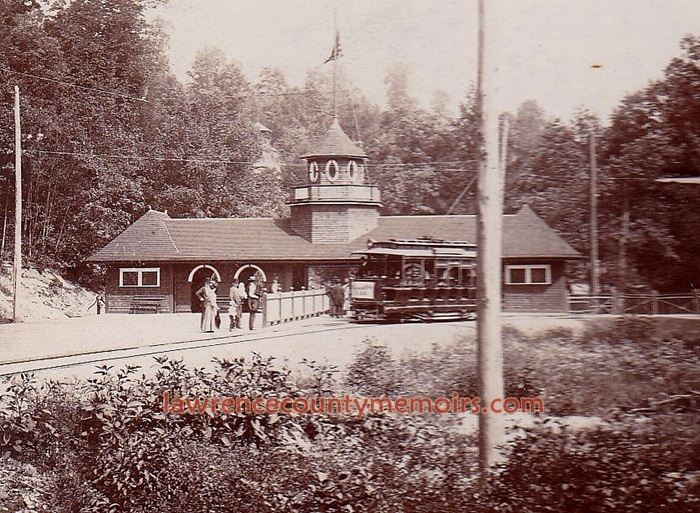 A streetcar of the Hamilton Street Line pulls up at the entrance to Cascade Park. (c1898) |
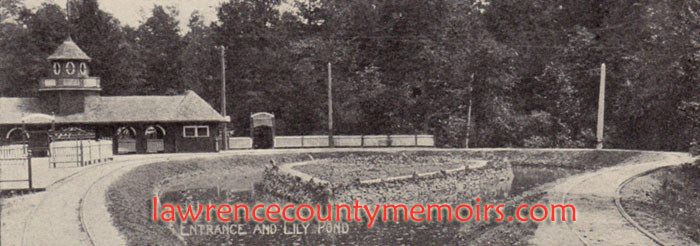 The main entrance to the park was originally located along Cascade Boulevard and accessible by street car along Hamilton Street. (c1903) |
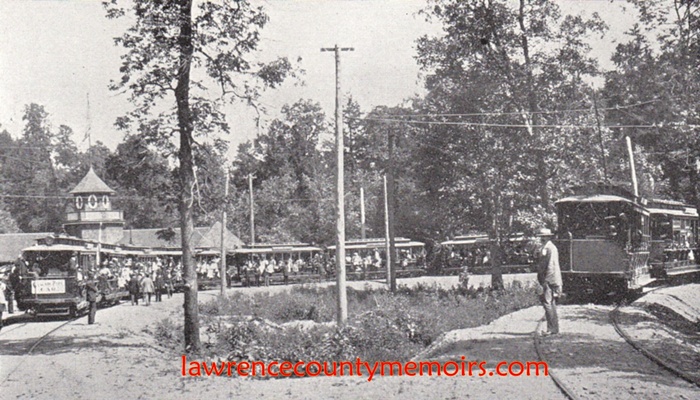 The main entrance of the park. (c1900) Full Size |
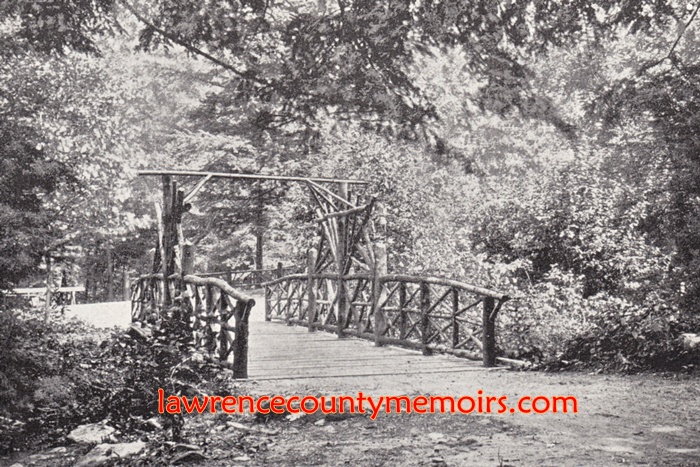 Bridge leading to the picnic grove. (c1900) | 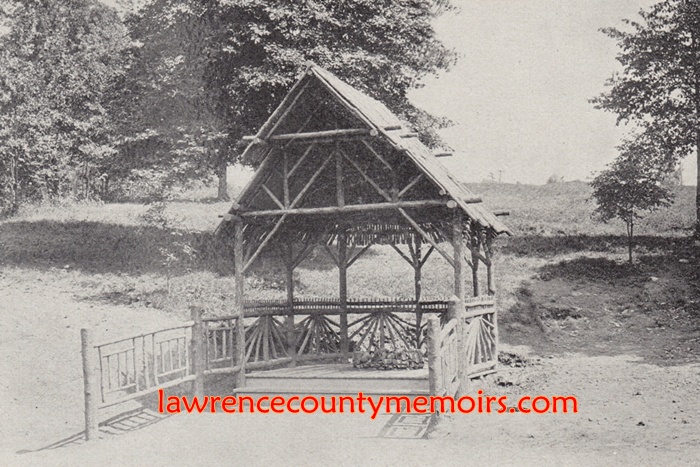 Boiling spring. (c1900) |
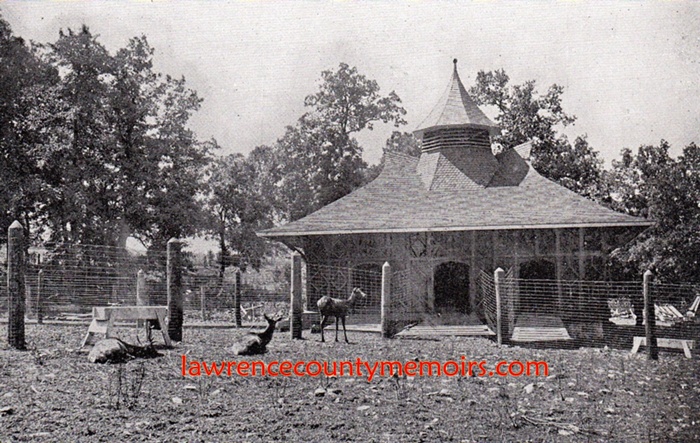 The Zoological Park. (c1900) Full Size |
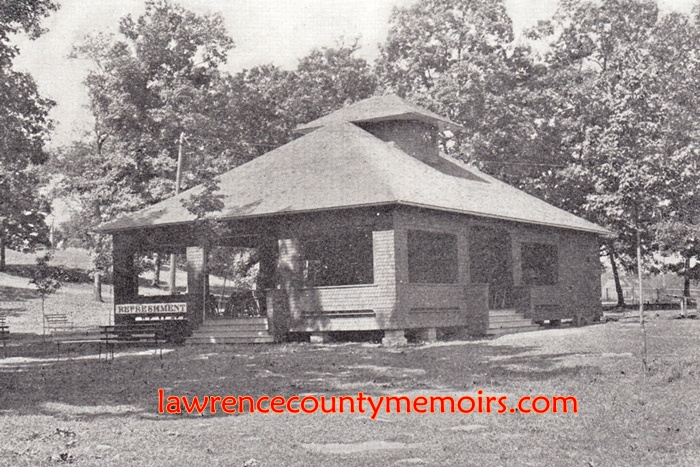 An early refreshment stand at the park. (c1900) | 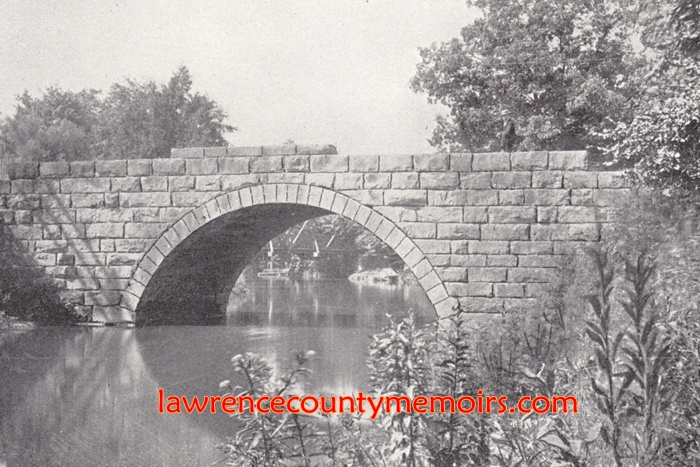 The stone bridge. (c1900) |
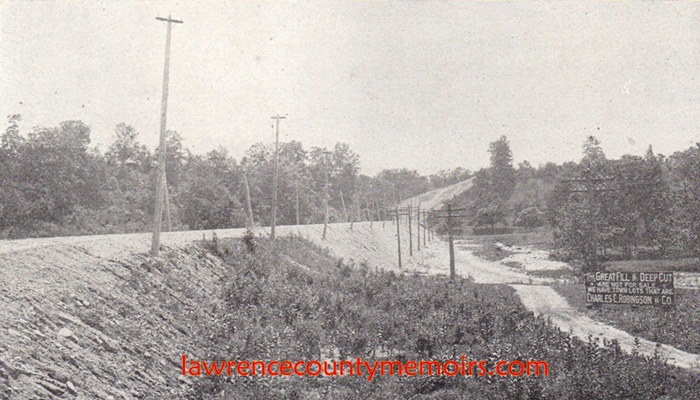 Identified as “The fill and cut.” This is the streetcar line and roadway (visible on right) leading down from Hamilton Street. (c1900) Full Size |
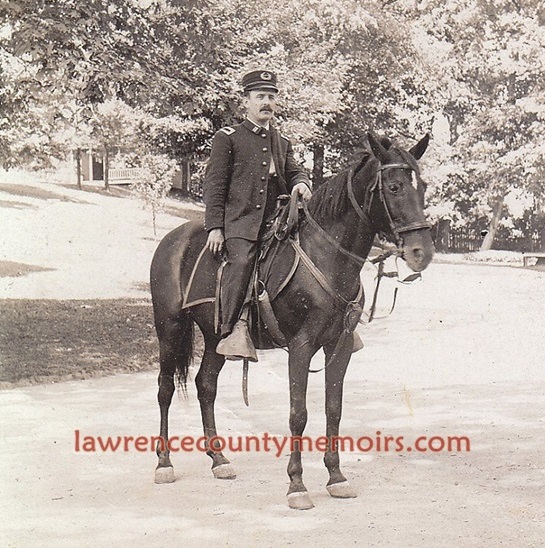 Perry Barge, a master carpenter employed with the New Castle Traction Company, served as the superintendent of Cascade Park from 1900 until 1908. He cast quite an imposing figure while riding around the park in uniform and perched atop his steed. After resigning the post he subsequently served as the manager of Idora Park in Youngstown. He later returned to Cascade Park and worked closely with the legendary Billy Glenn. Barge, as Glenn’s right hand man, oversaw the construction of the “Gorge Ride” roller coaster in 1922 and operated the ride for several years. (1907) Full Size |
 Mineral spring. (c1900) | 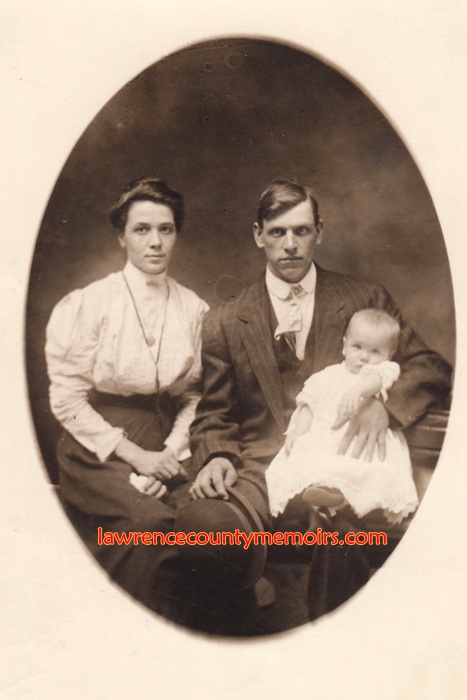 Mr. and Mrs Milton Plufg and their baby. Taken at Conn’s Photo Gallery at Cascade Park in August 1911. (1911) |
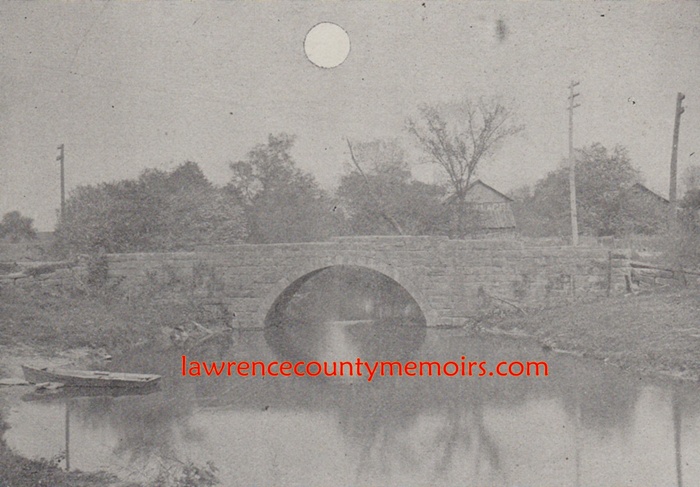 The stone bridge in the moonlight. (c1900) Full Size |
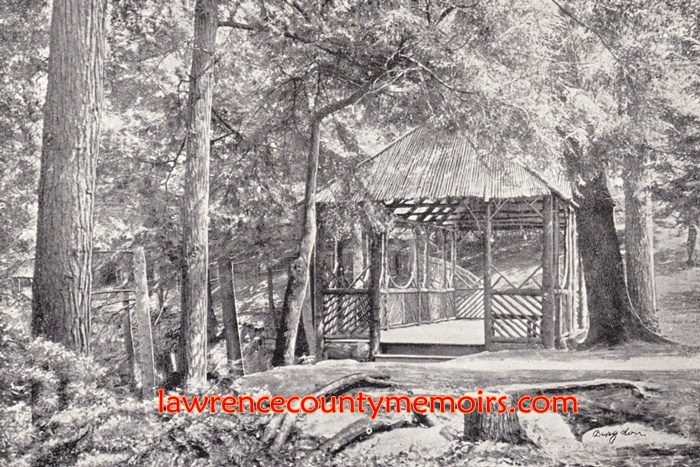 One of the many picnic shelters. (c1900) | 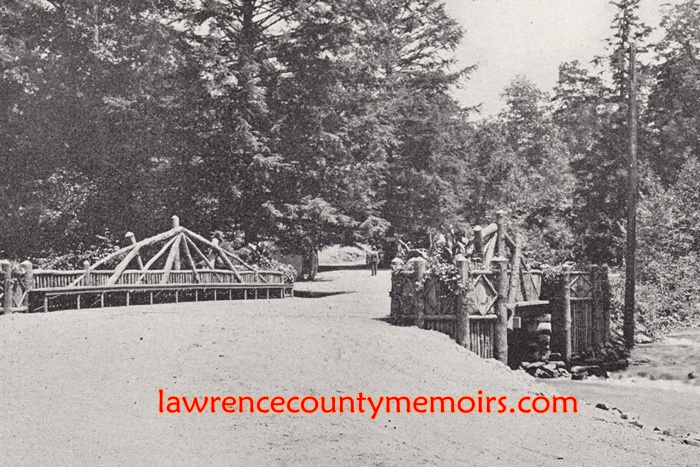 The floral bridge. (c1900) |
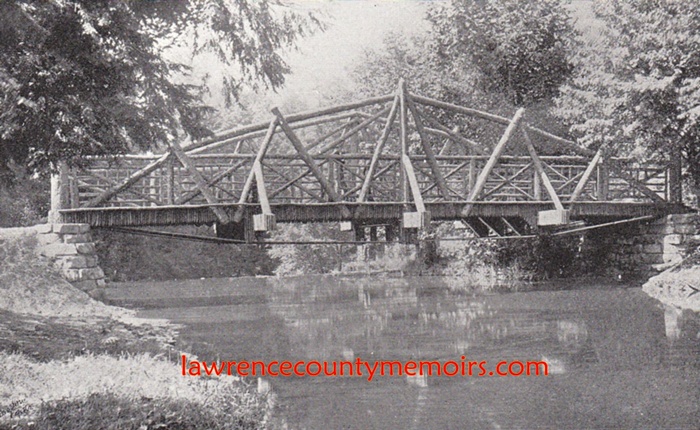 (c1900) Full Size |
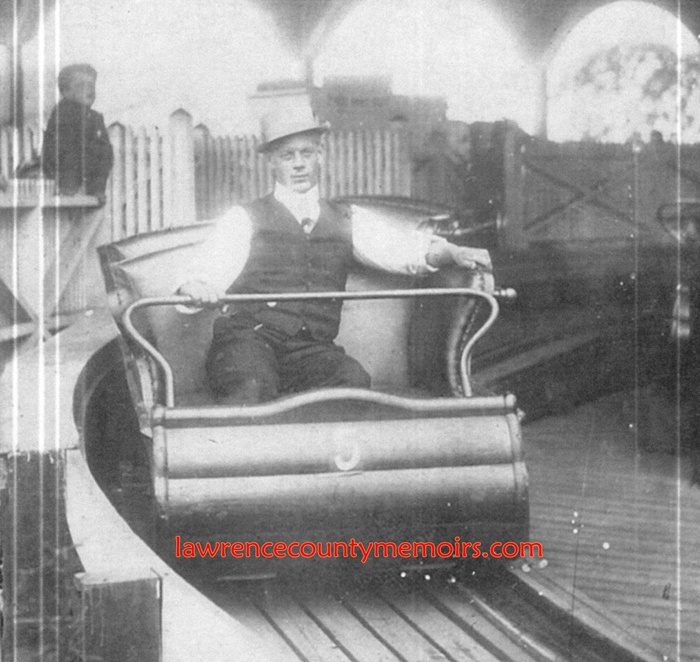 A patron enjoys one of the early amusement rides at the popular park. (c1909) Full Size |
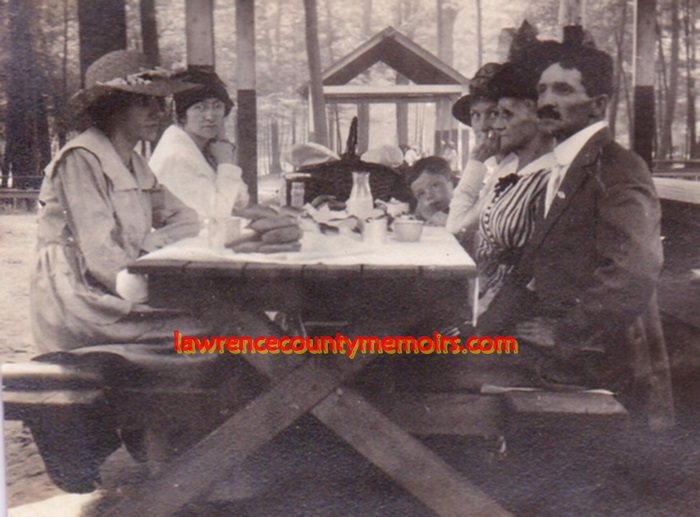 A family enjoys a picnic at Cascade Park in 1917. (June 1917) |
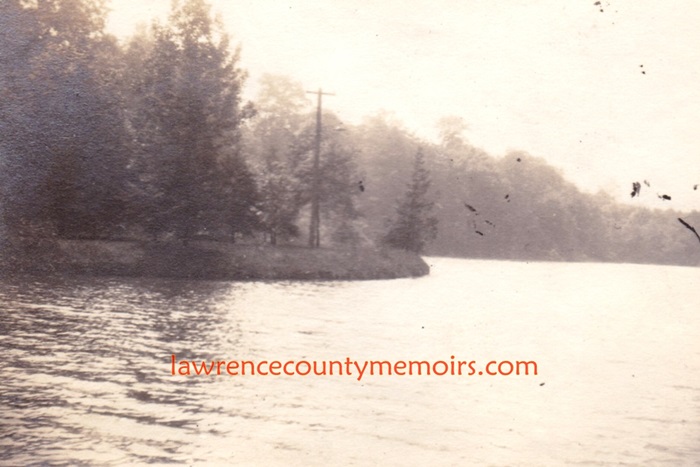 Cascade Lake in the summer of 1917. (Jun 1917) | 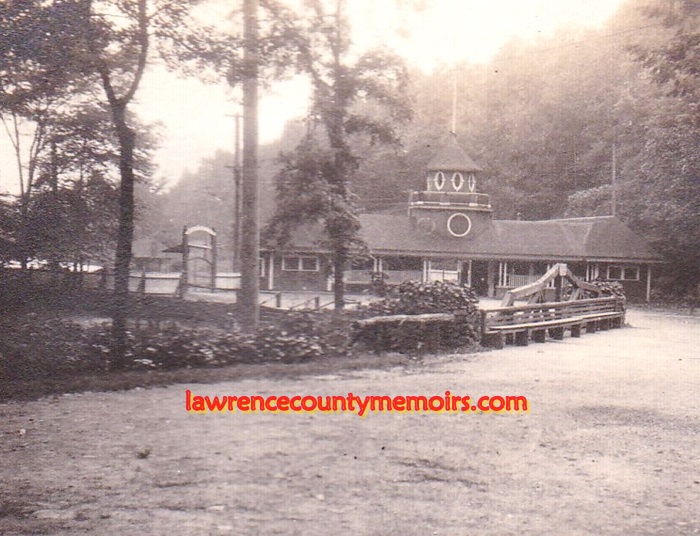 The entrance area of Cascade Park. (Jun 1917) |
 A family photo on the bridge near the entrance to the park. (Jun 1917) |
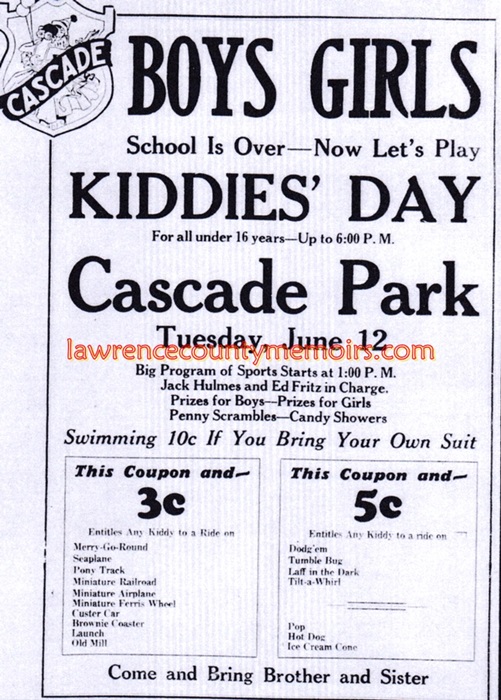 An advertisement for the park from June 1928. Full Size |
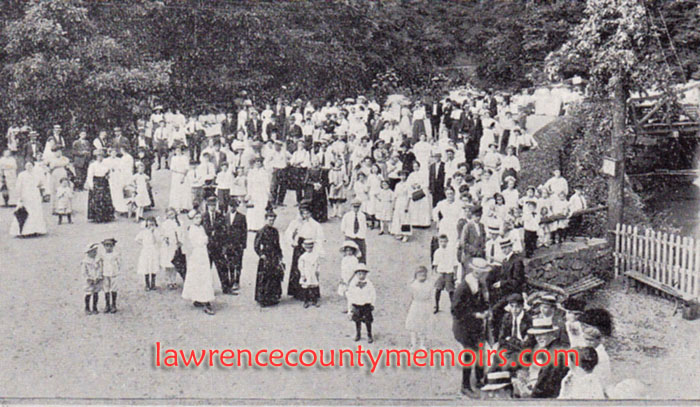 A Sunday afternoon crowd enjoys the day at Cascade Park. (c1902) |
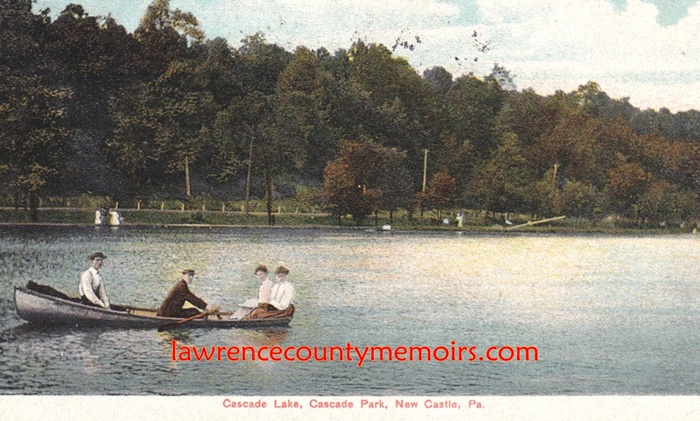 Park patrons enjoy an afternoon out on the lake. (1908) Full Size |
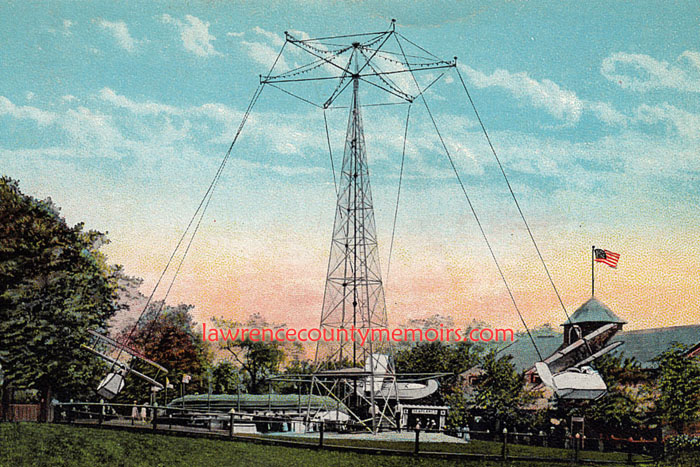 The Seaplane ride. c1910. | 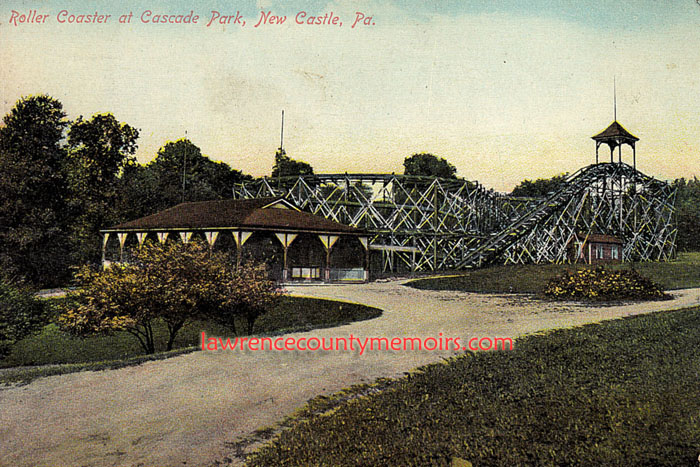 Seen here in the early 1900’s the small original roller coaster, sometimes referred to as The Toboggan, was replaced by the Gorge Ride coaster in 1922. |
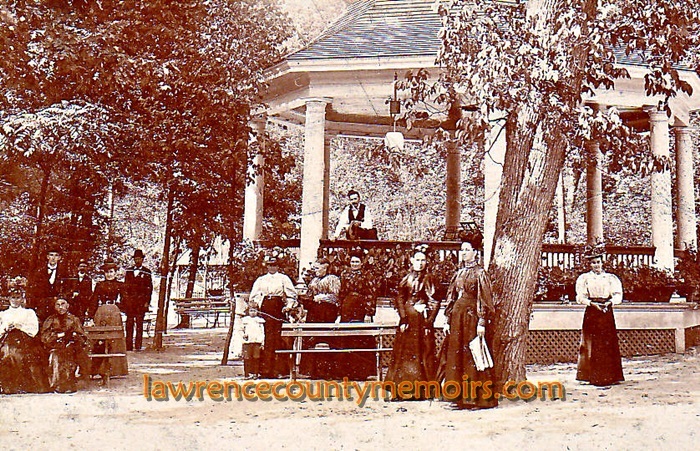 The bandstand at the park. (c1900) Full Size |
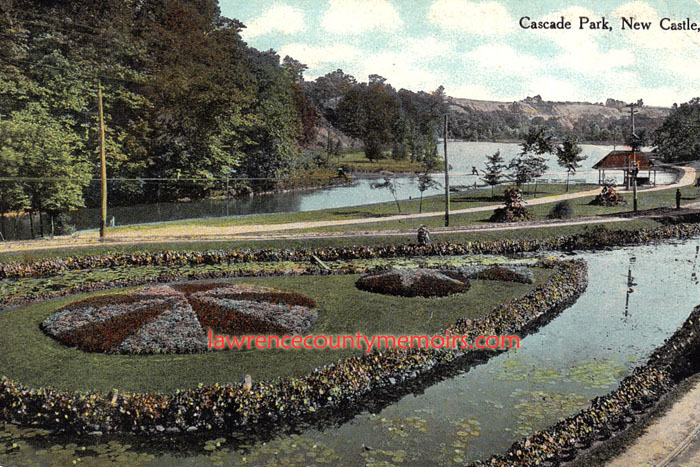 View of the lilly pond and the fifteen-acre lake at Cascade Park near the main (now rear) entrance to Cascade Park. (1910) | 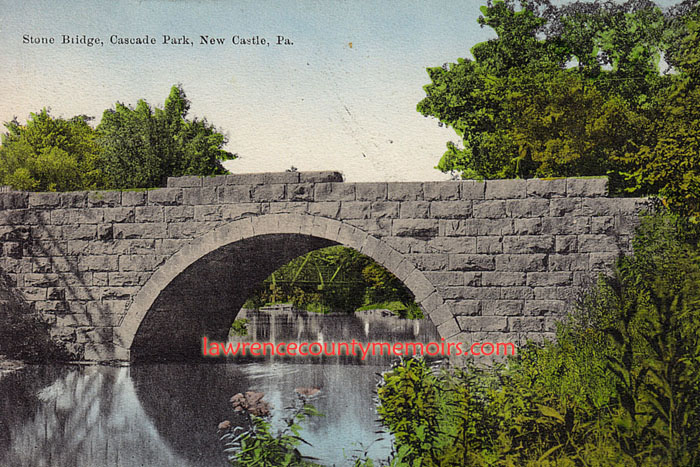 The Stone Bridge at the park. 1908. |
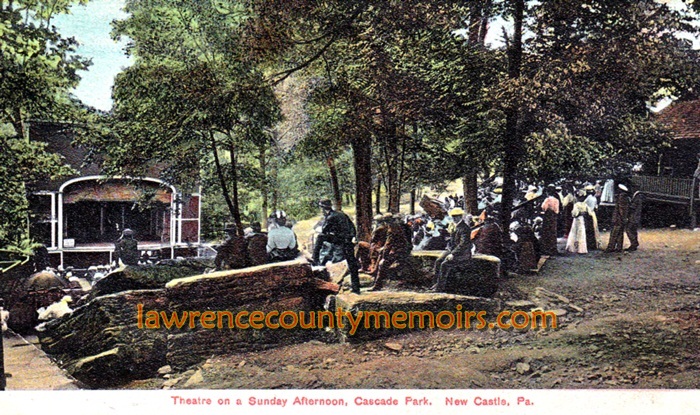 A small crowd takes in the Sunday show at the theater. (c1901) Full Size |
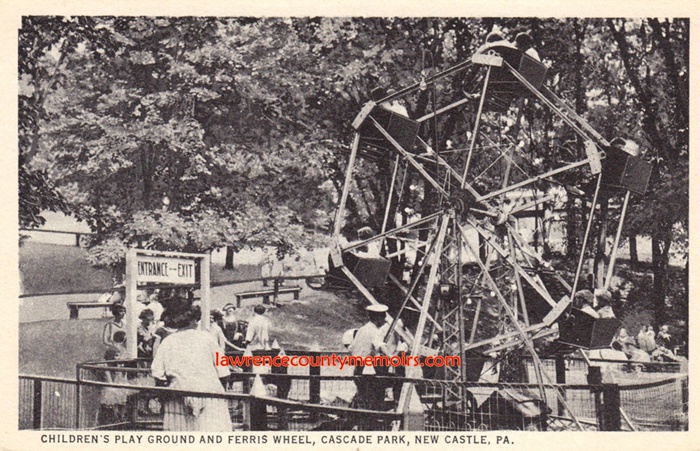 The miniature ferris wheel at the park. (c1930) Full Size |
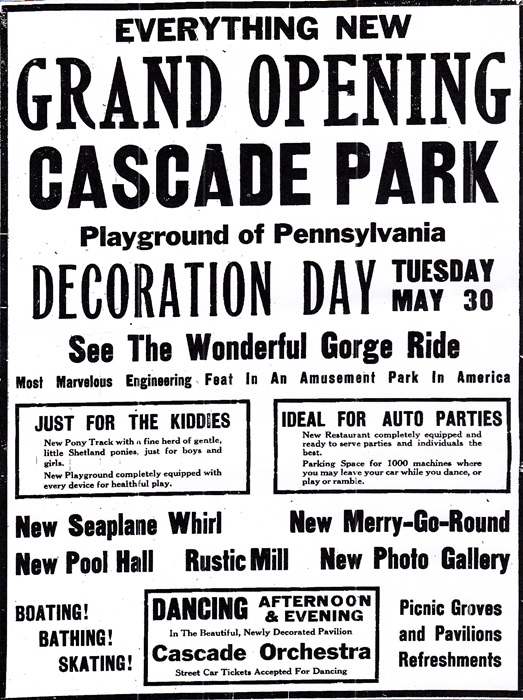 An advertisement, announcing the opening of the park for the summer season, that appeared in the New Castle News of Saturday, May 27, 1922. |
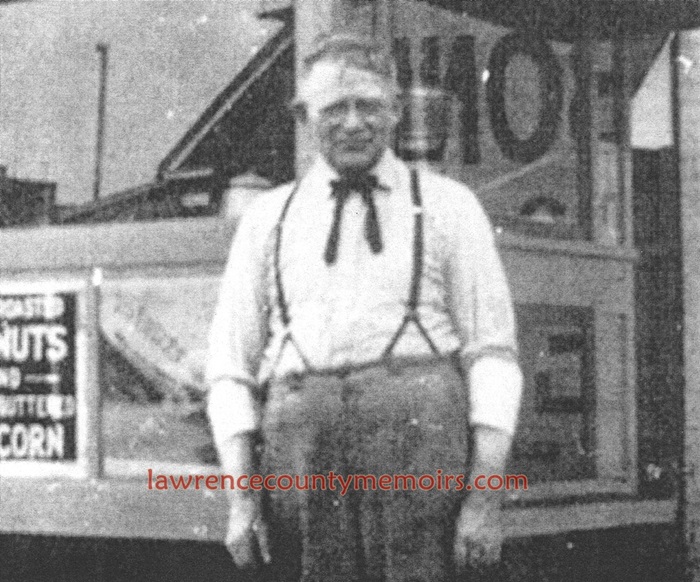 The incomparable Billy Glenn remains a legend in New Castle. He sold peanuts and popcorn, from a wagon and at Cascade Park, for almost sixty years. (c1935) |
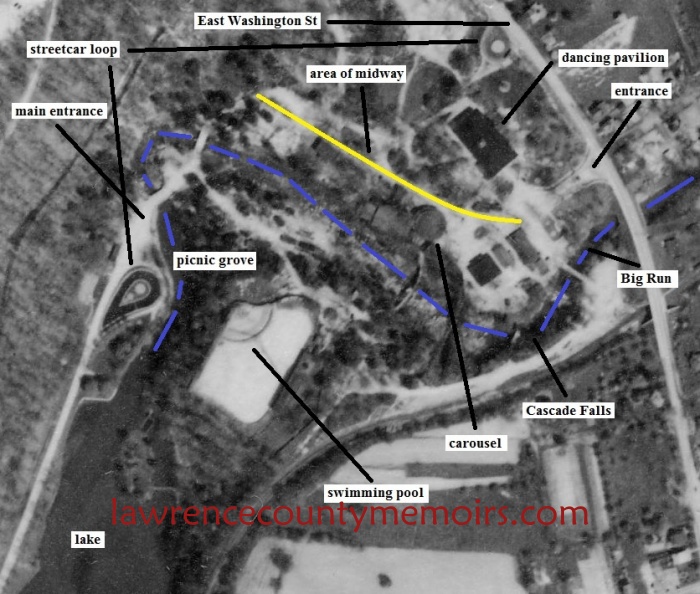 This overhead photo reveals the location of various attractions at Cascade Park. The broken blue line is the route of Big Run through the park area. (1939) |
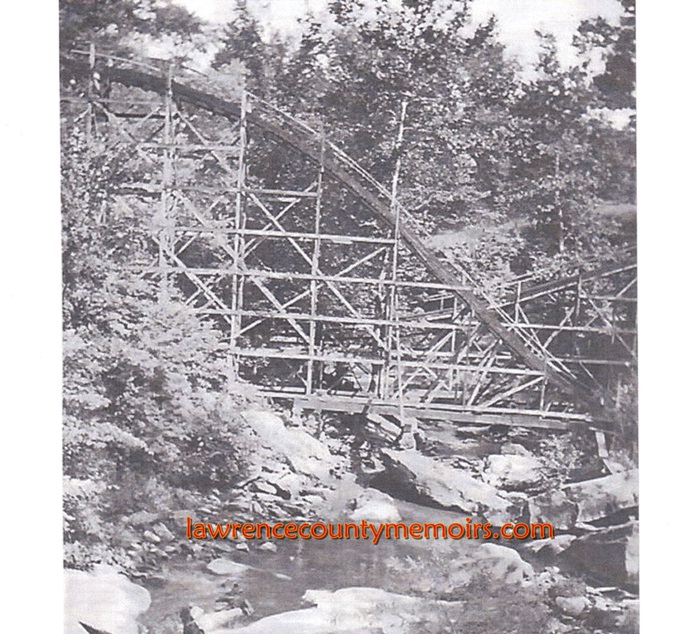 A photo of the old rollercoaster known as The Gorge Ride. (c1930) (Courtesy of Sherry Slater) Full Size |
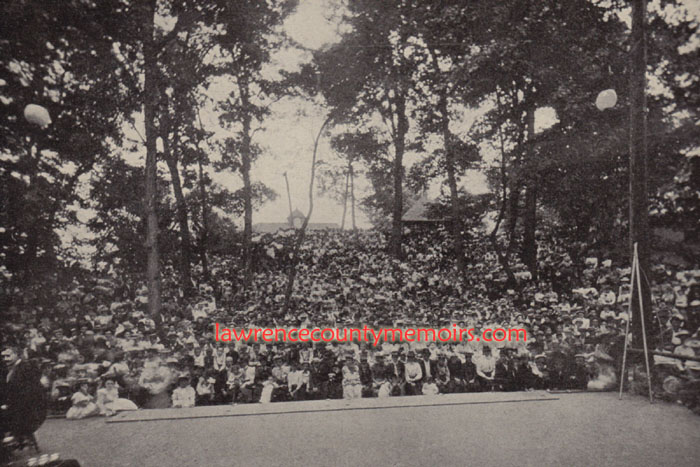 A crowd gathers by the theater. (c1902) | 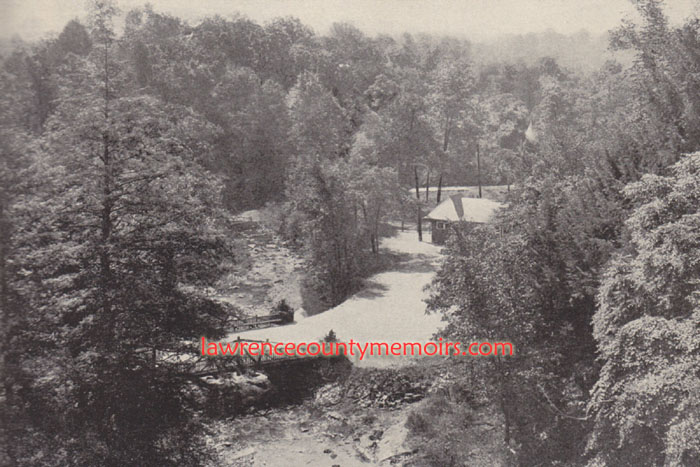 A view of the park from above. (c1902) |
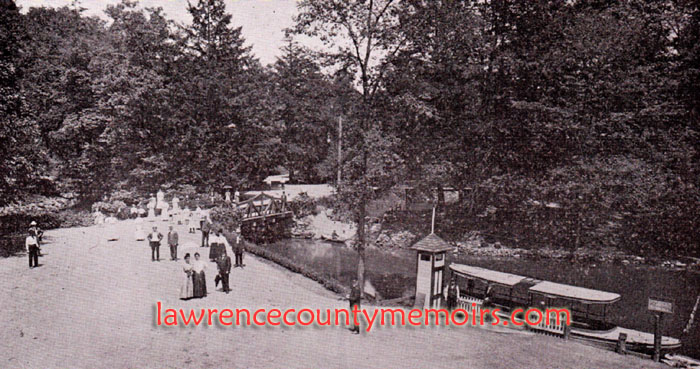 A view of the boat launch area near the old entrance to the park. (c1902) Full Size |
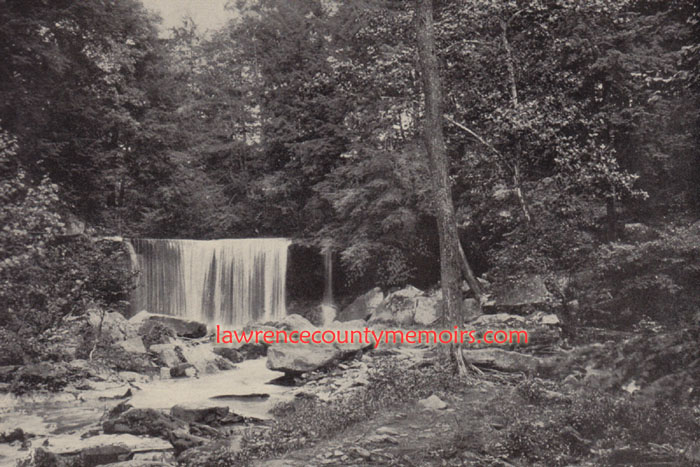 Big Run Falls. (c1904) | 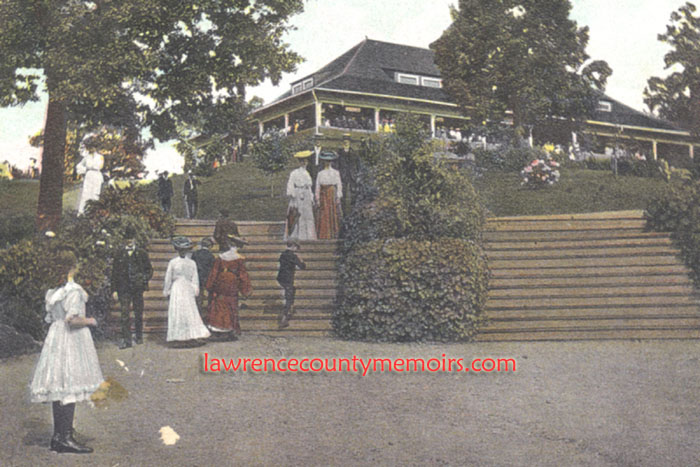 Folks gather near the Floral Steps. (c1908) |
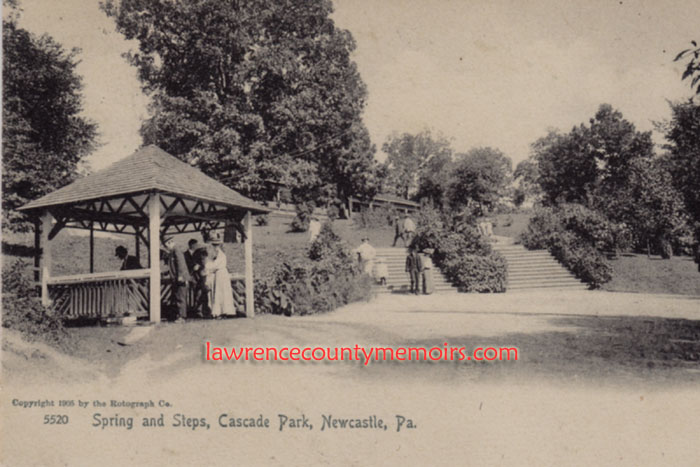 A gazebo near the Floral Steps. (c1905) | 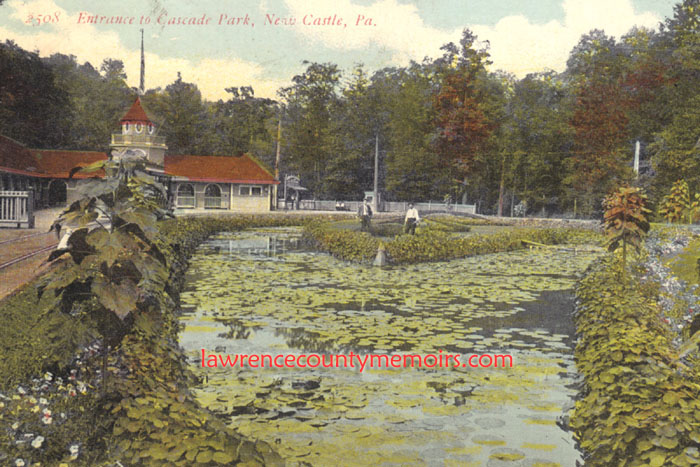 The lily pond near the entrance. (c1909) |
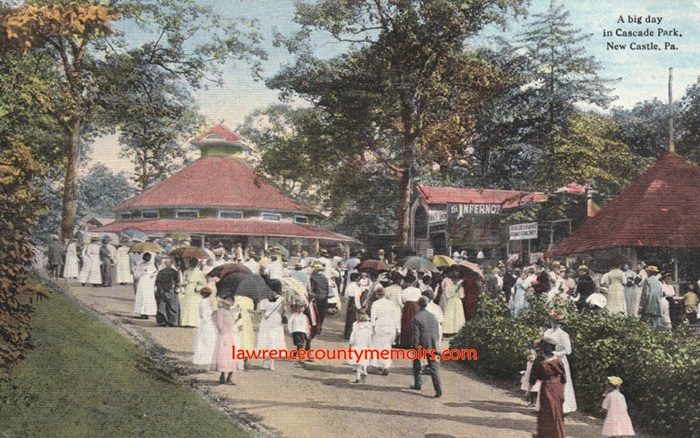 This postcard was sent to Mrs. E. M. Morris in South Framingham MA and inscribed, “We have been in Pa for about 3 weeks. Well and all the folks are well. It has been pretty cold here but not much snow. We will be going back soon. Julia.” Postmarked in Mahoningtown on Feb 24, 1915. Full Size |
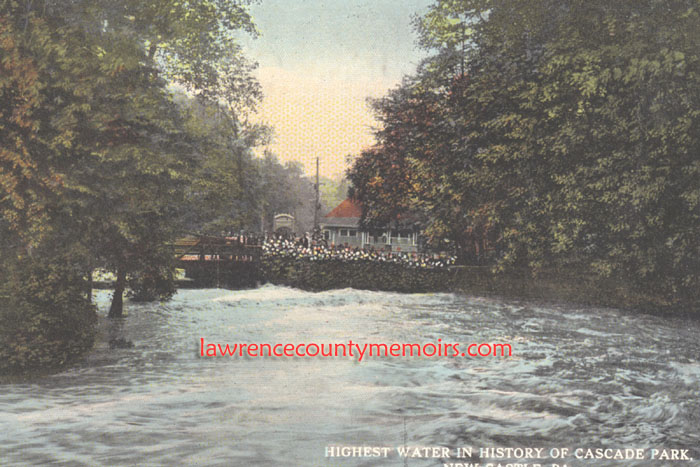 The raging waters of Big Run during the Great Flood of March 1913. (1913) | 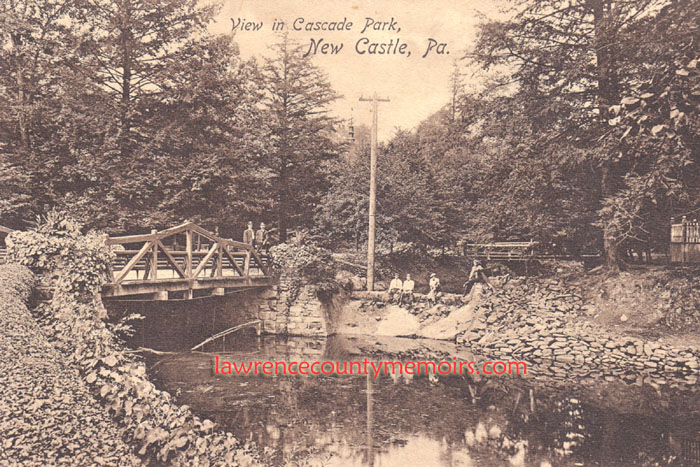 The old bridge. (c1909) |
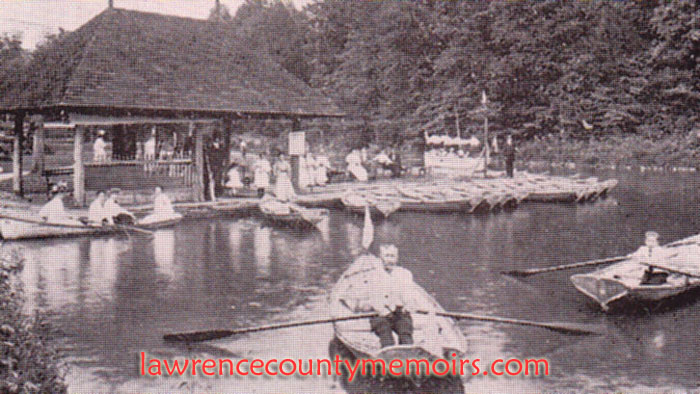 The old boat house on the lake. (c1907) Full Size |
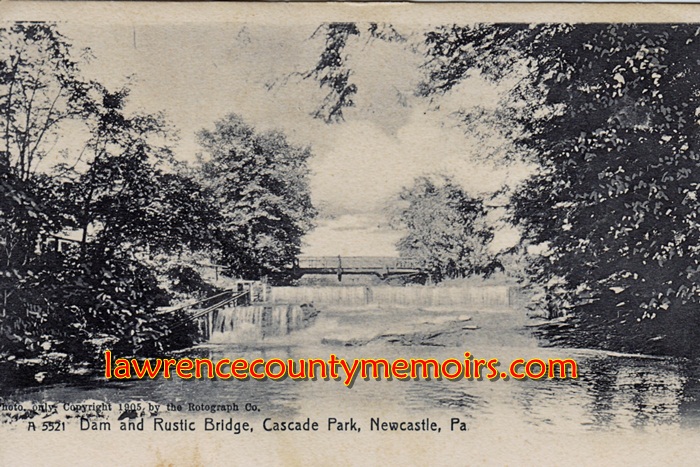 (c1905) | 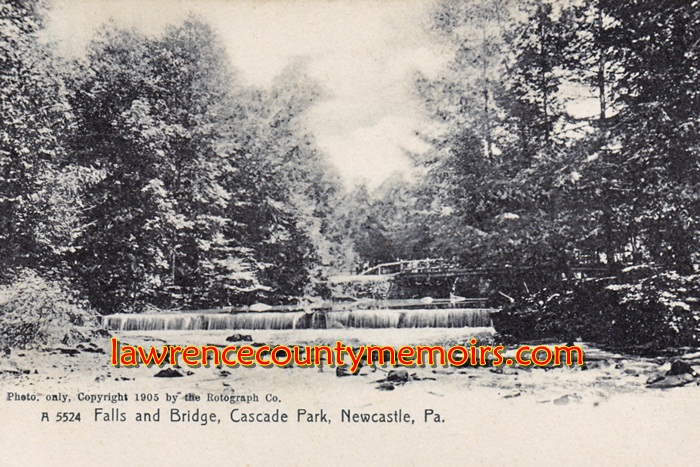 (c1905) |
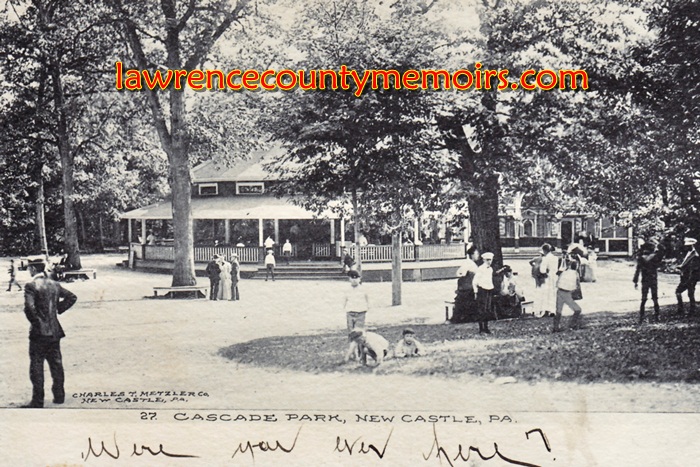 The area around the carousel house. (c1906) |
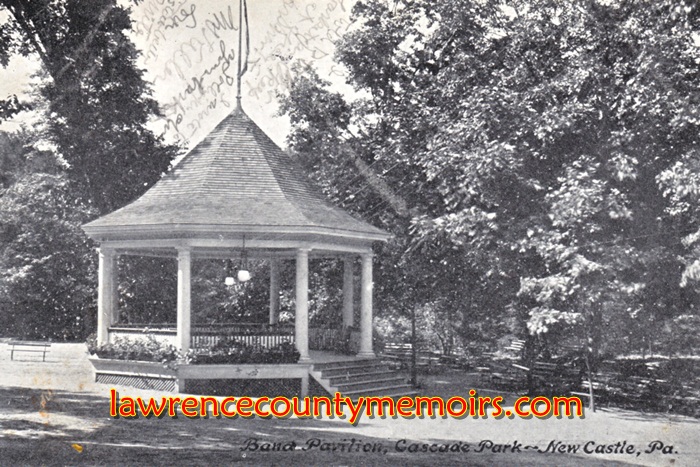 (c1904) | 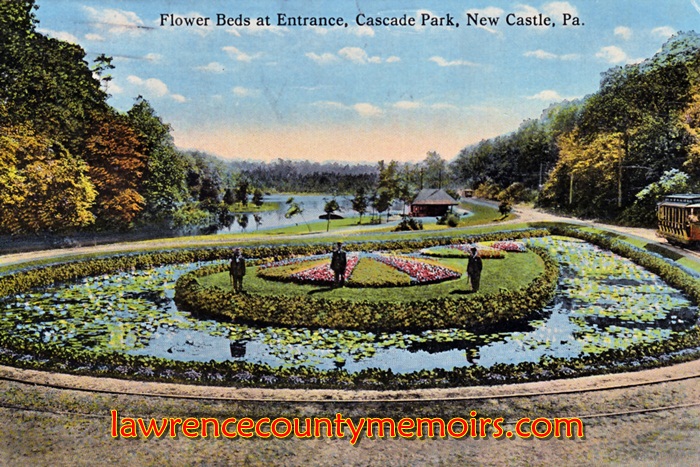 (c1915) |
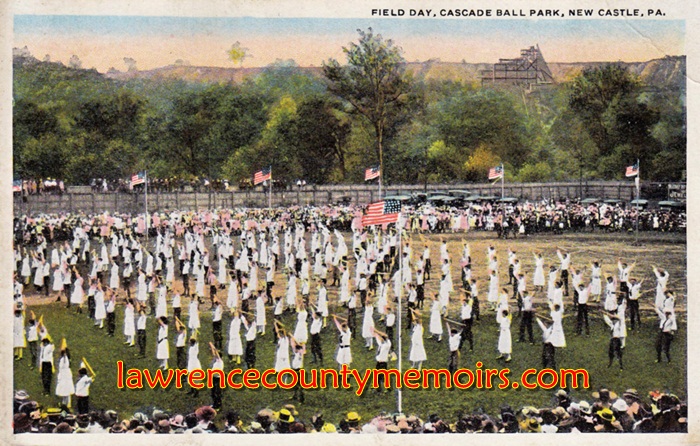 Local students gather for Field Day at Cascade Park. (c1913) Full Size |
 (c1916) | 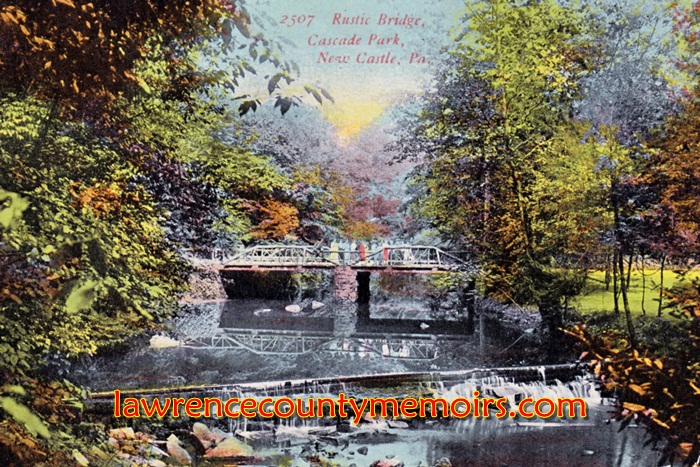 (c1916) |
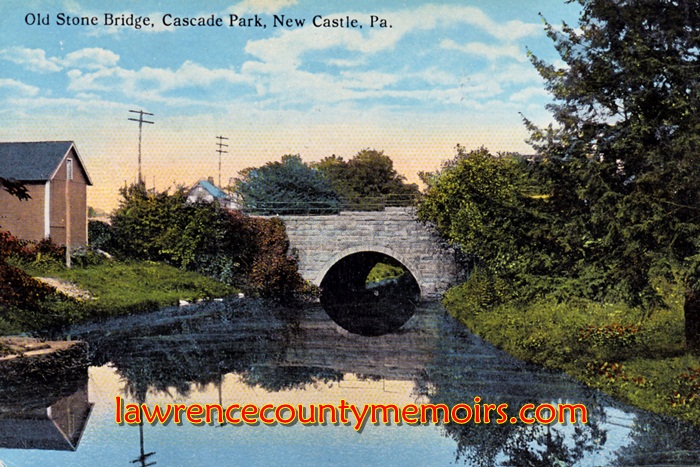 (c1915) | 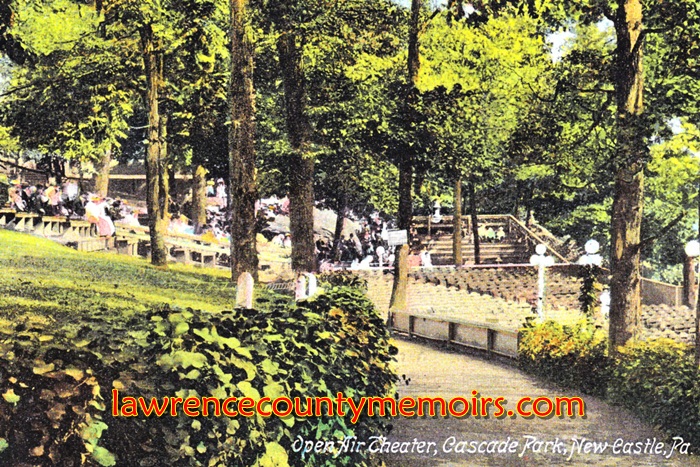 (c1915) |
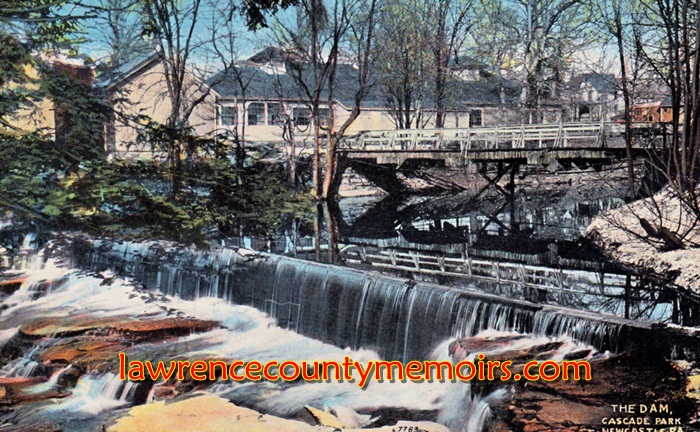 The dam on Big Run. (c1920) Full Size |
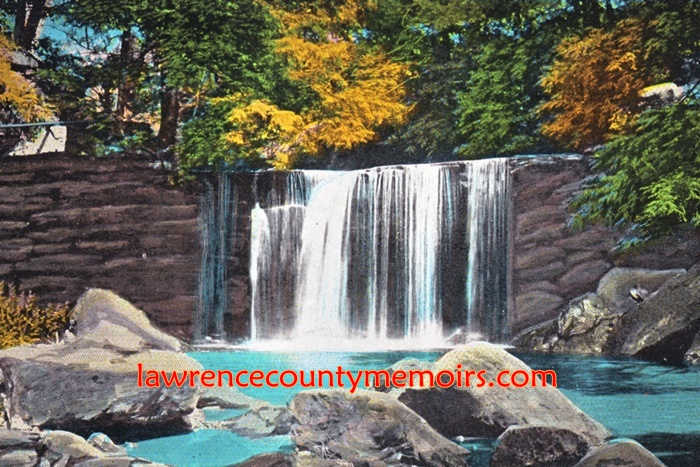 Cascade Falls. (1914) | 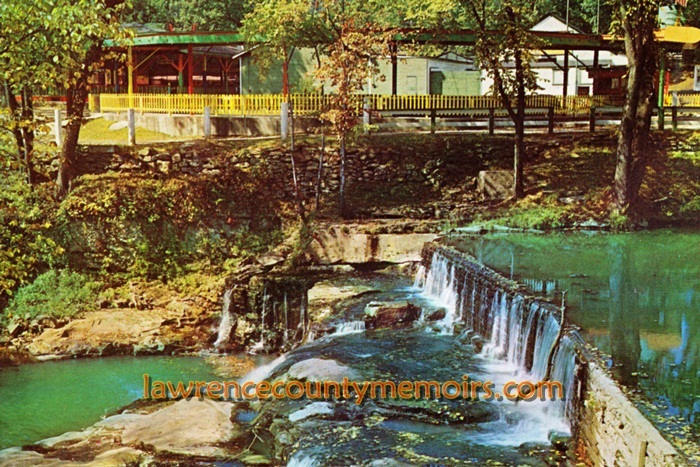 Cascade Falls. (c1950) |
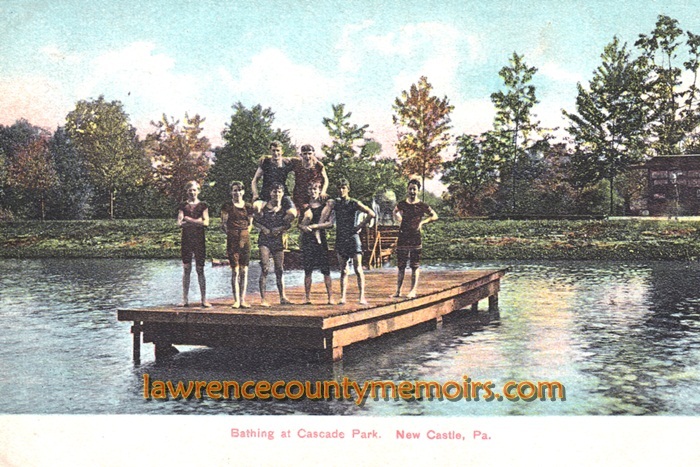 A group of young men enjoying the lake. (c1902) |
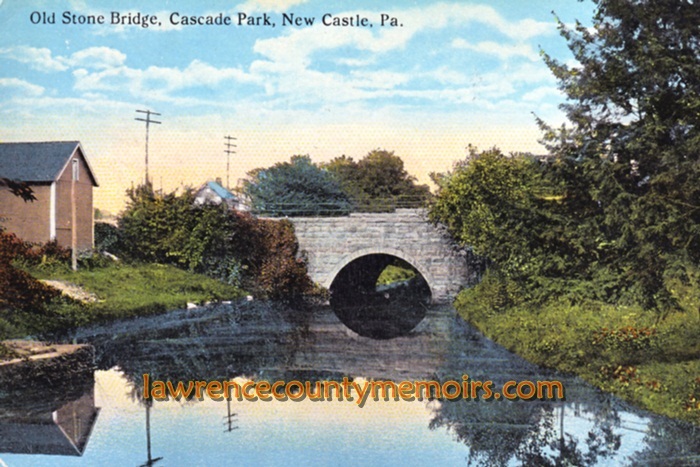 Old stone bridge at the park. (1920) | 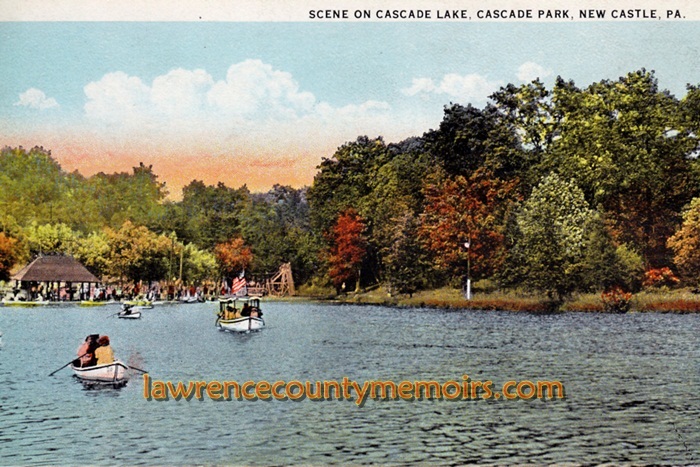 Boaters enjoy a day on the lake. (c1915) |
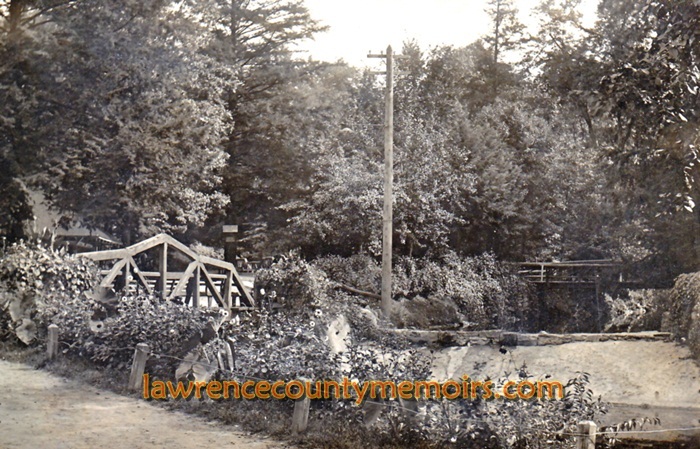 A scene near the lake. (c1905) Full Size |
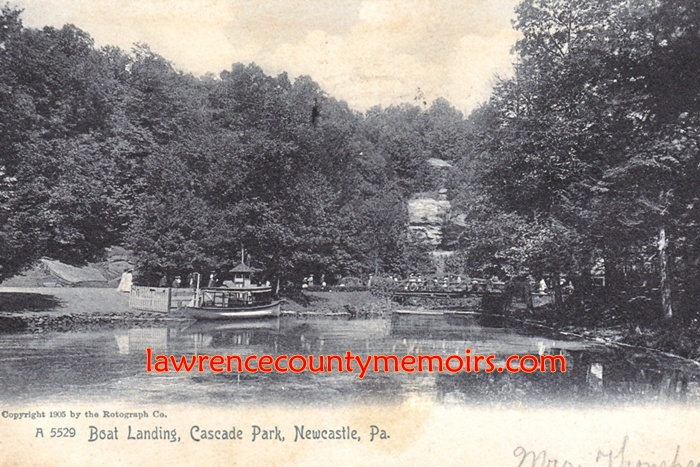 The boat launch area. (c1906) | 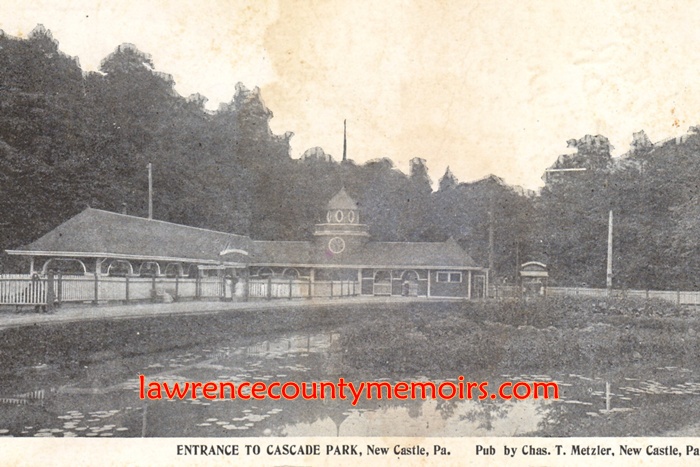 The main entrance. (c1905) |
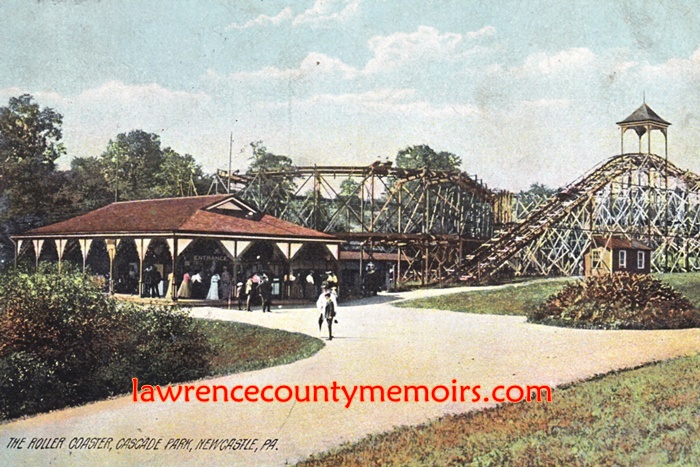 The original coaster at the park, often referred to as the Toboggan. (c1905) | 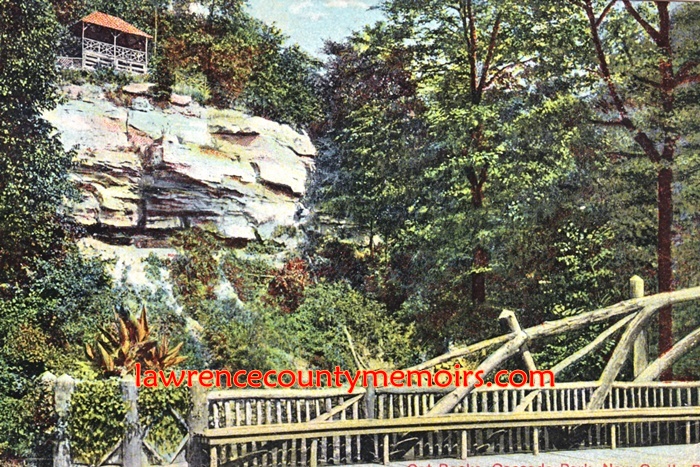 Cat Rocks. (c1910) |
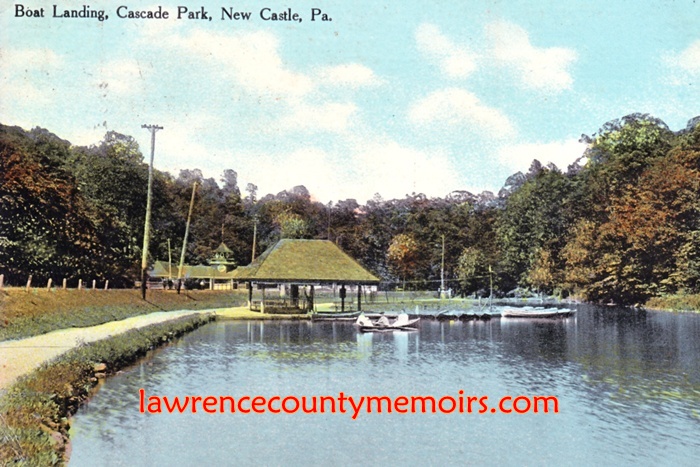 The lake at Cascade Park. (c1909) | 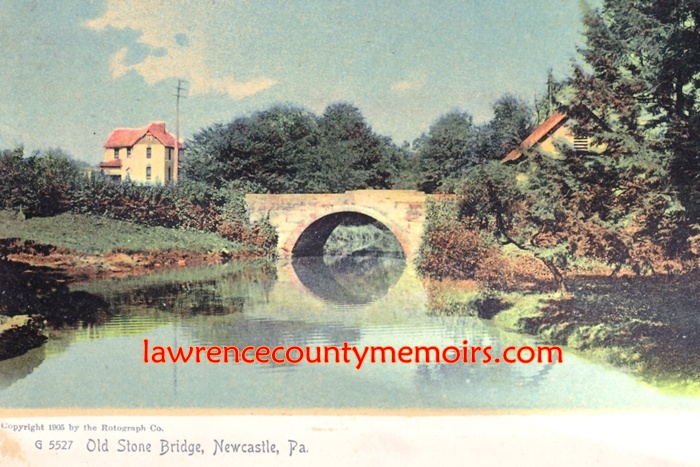 (c1909) |
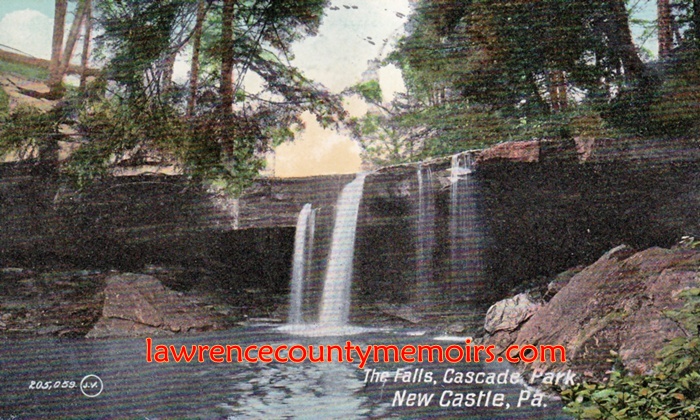 The picturesque waterfall has always been a popular spot. (c1914) Full Size |
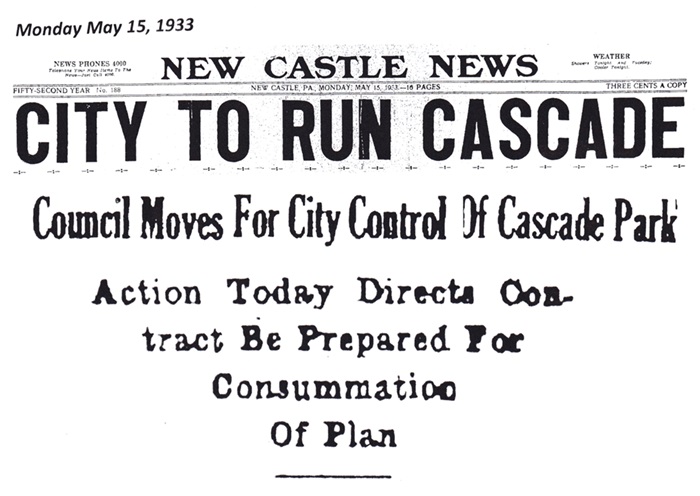 |
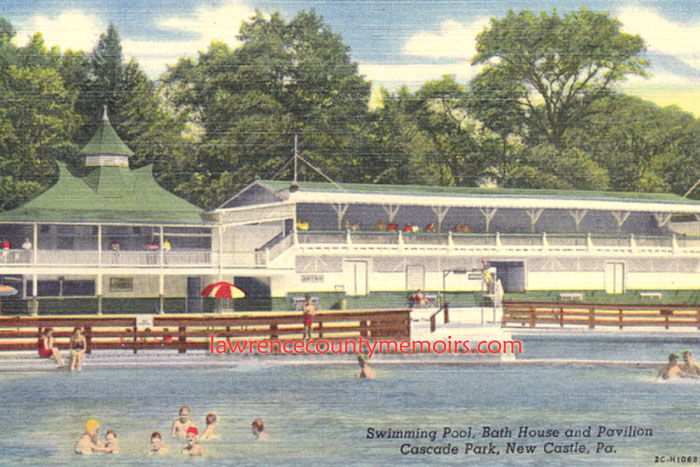 The large swimming pool funded and built by Billy Glenn opened in the summer of 1926. It was located on the site that formerly housed the zoo. (c1935) |
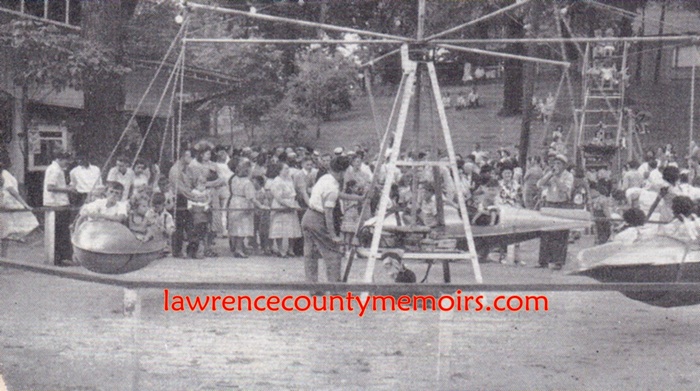 (1946) Full Size |
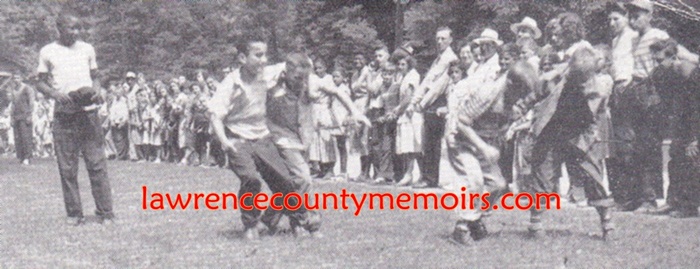 (1946) Full Size |
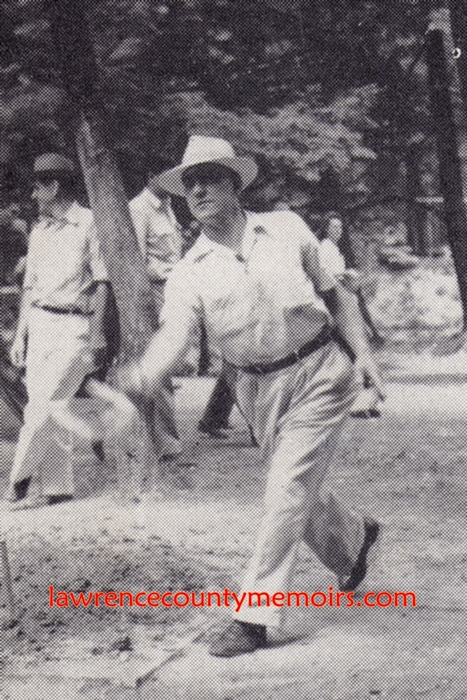 (1946) | 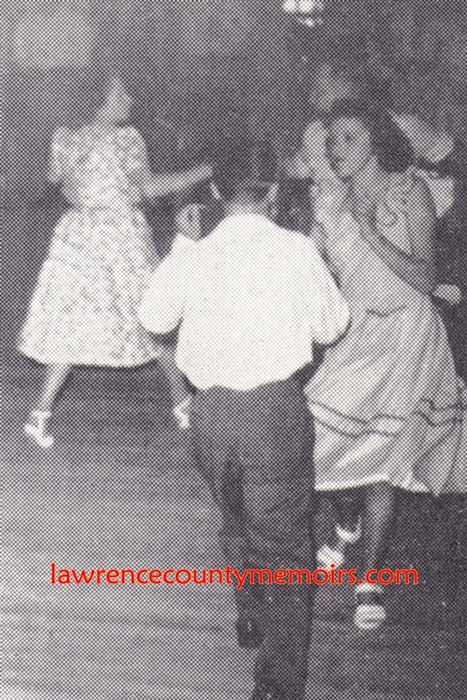 (1946) |
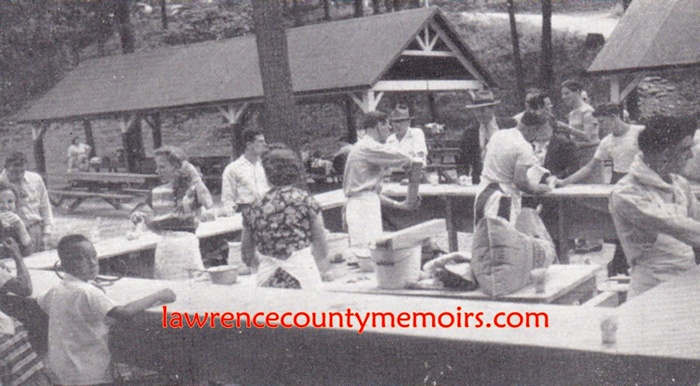 (1946) Full Size |
 (1946) | 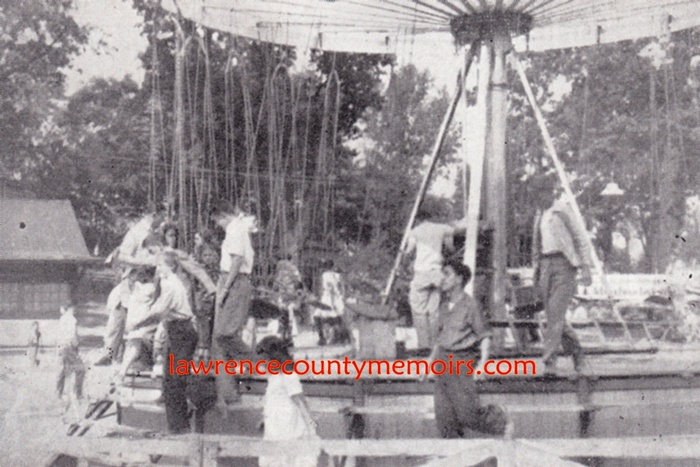 (1946) |
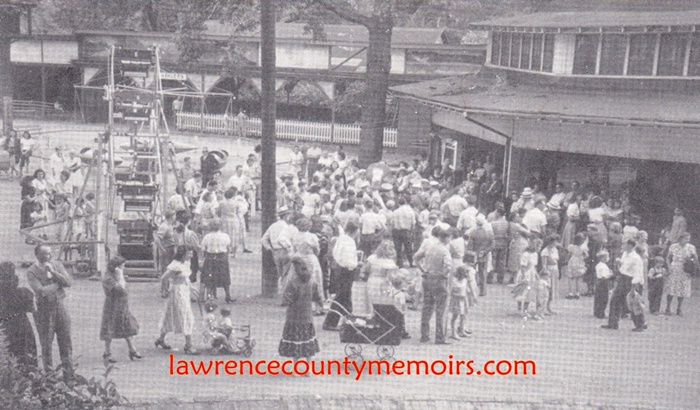 (1946) Full Size |
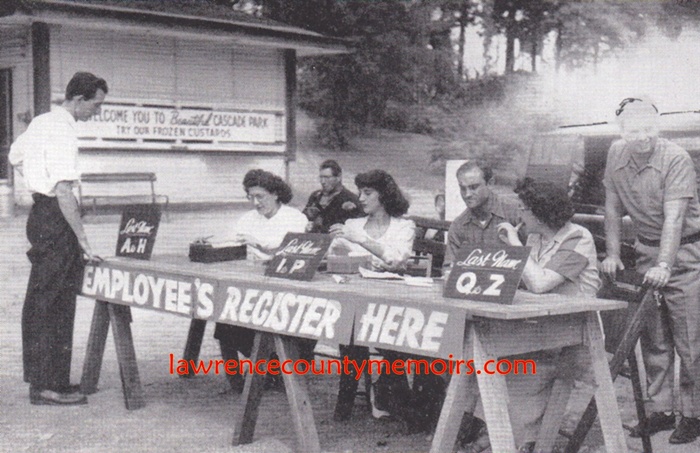 Organizers prepare for the start of the Johnson Bronze Employees Picnic on Sat, Sept 3, 1949. An estimated 3,800 JB employees and the family members attended. It was reported that they consumed a total of 4,563 hot dogs! (Sept 1949) Full Size |
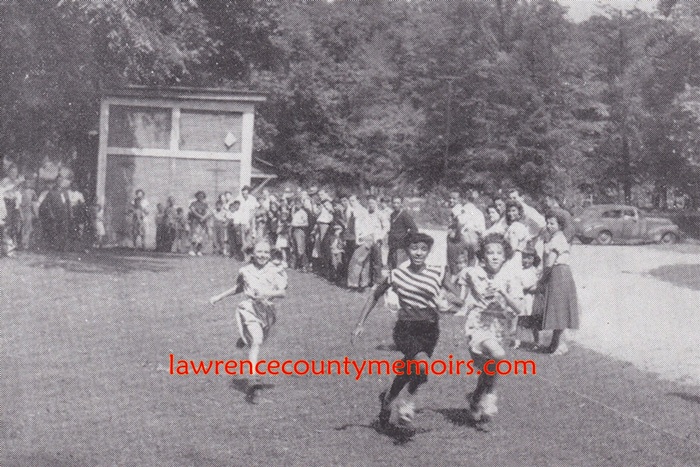 (1949) | 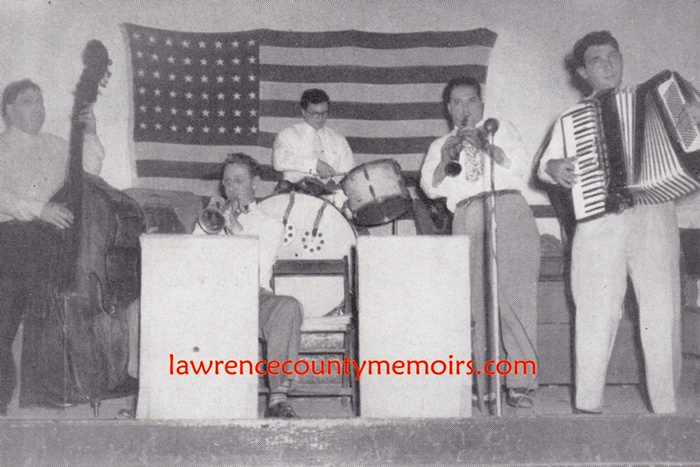 A polka band in action at the park. (1949) |
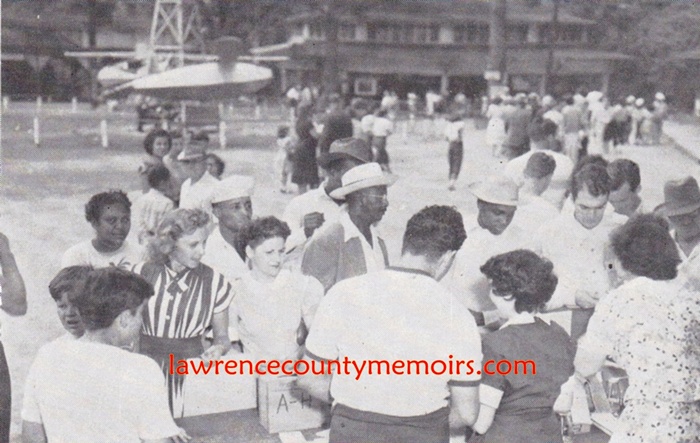 Employees of the Johnson Bronze company during the 1950 company picnic. (Aug 1950) Full Size |
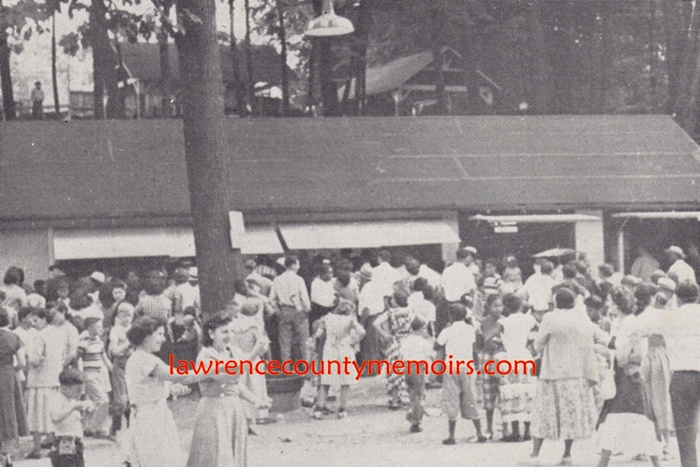 (1950) | 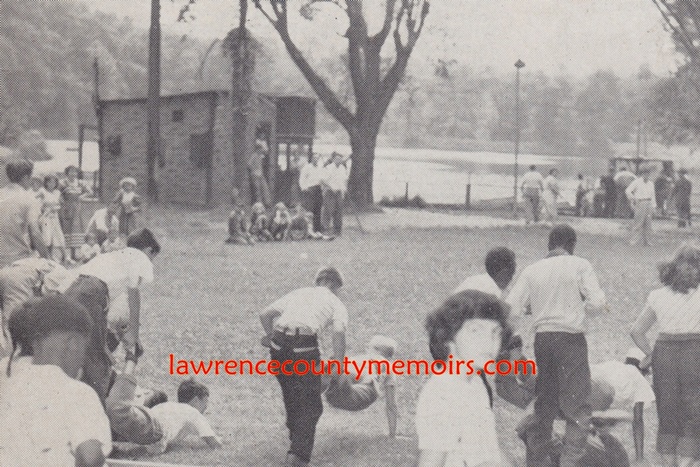 (1950) |
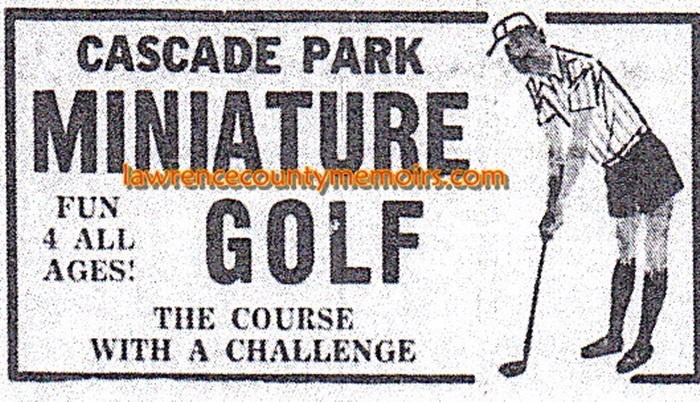 (c1950) |
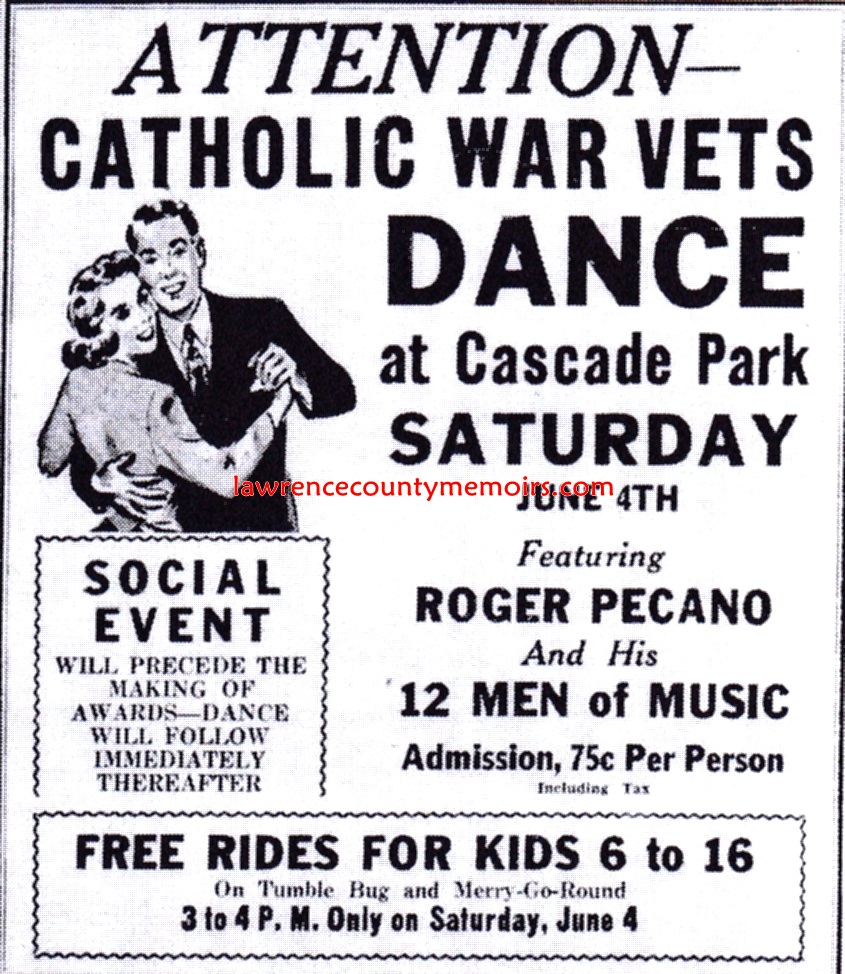 (June 1949) |
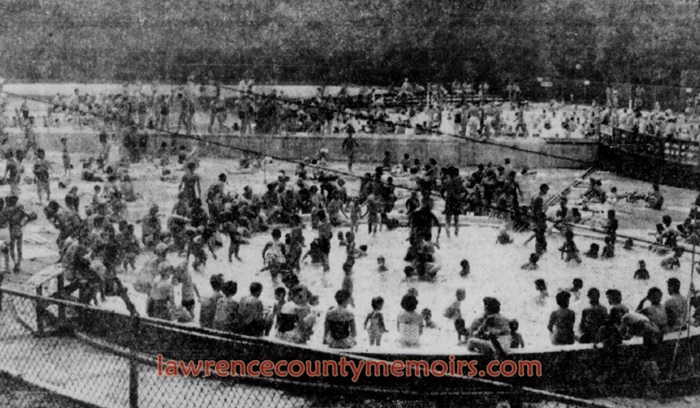 The old swimming pool, built by Billy Glenn back in 1926, was typically packed during the Fourth of July celebrations every year. (July 1955) |
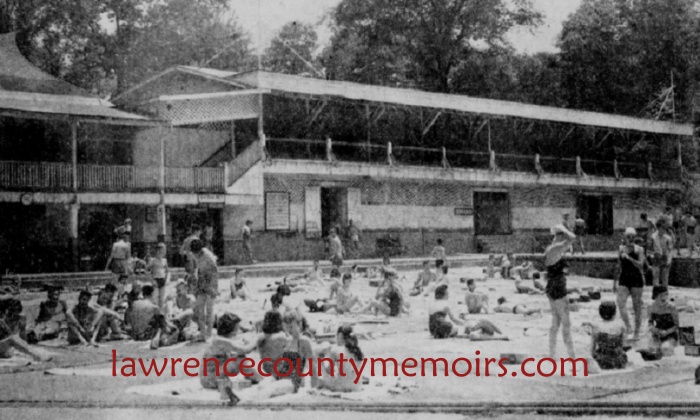 Patrons relax at the old swimming pool at Cascade Park. (Jul 1956) |
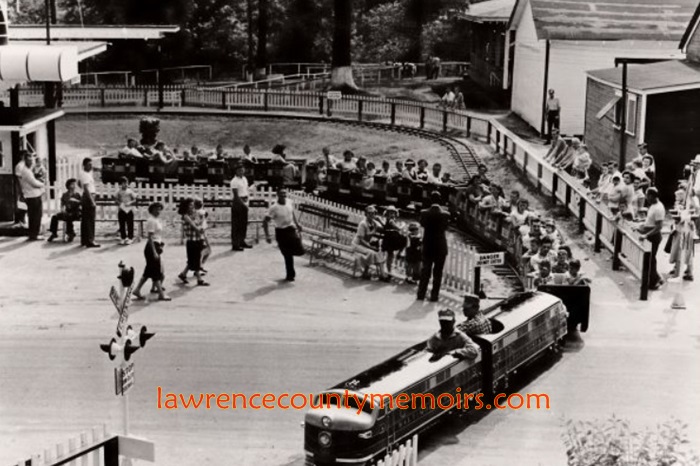 The miniature train prepares to leave its station at Cascade Park. (c1960) |
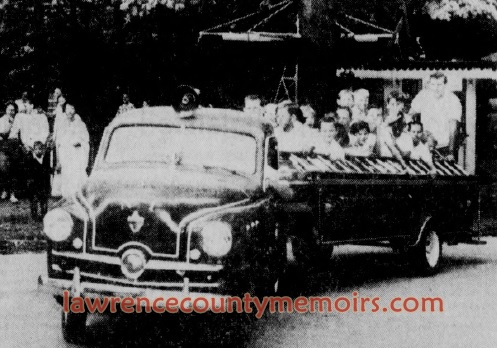 The miniature fire truck that once paraded young kids around the park. (1960) |
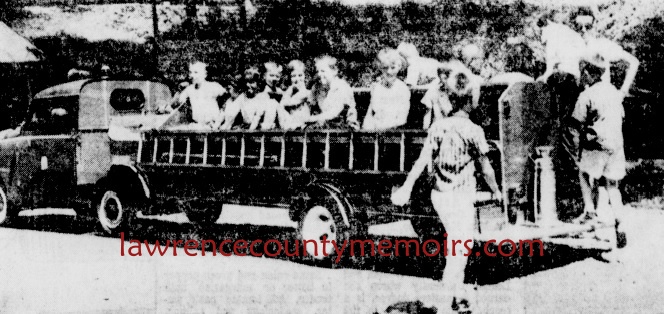 Another photo of a popular miniature firetruck at Cascade Park. (Aug 1965) |
 (Sep 1961) |
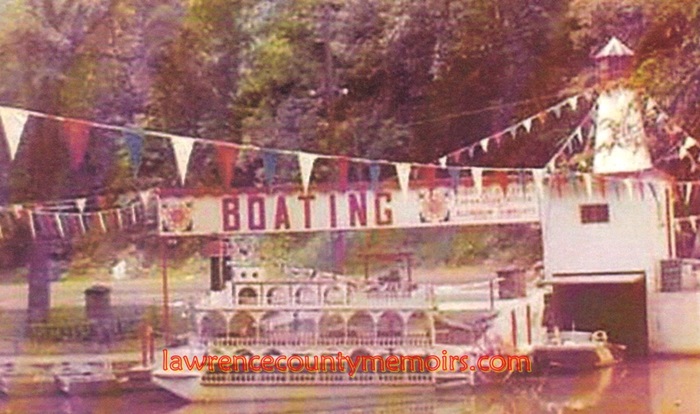 In late 1960 the park took possession of a miniature riverboat from Michigan. A new concession and dock were soon erected to handle the boat, which was debuted for rides during the summer of 1961. (c1970) (Courtesy of Kevin Gierlach) Full Size |
 The miniature riverboat, dubbed Cascade Katie, was sunk during severe weather in early February 1971. The vessel was re-floated, repaired, and apparently put back in service. (1971) |
 Paul Vesco and city officials worked together to fund and build four new horseshoe courts in the summer of 1971. Cascade Katie is seen in background. (Jul 1971) |
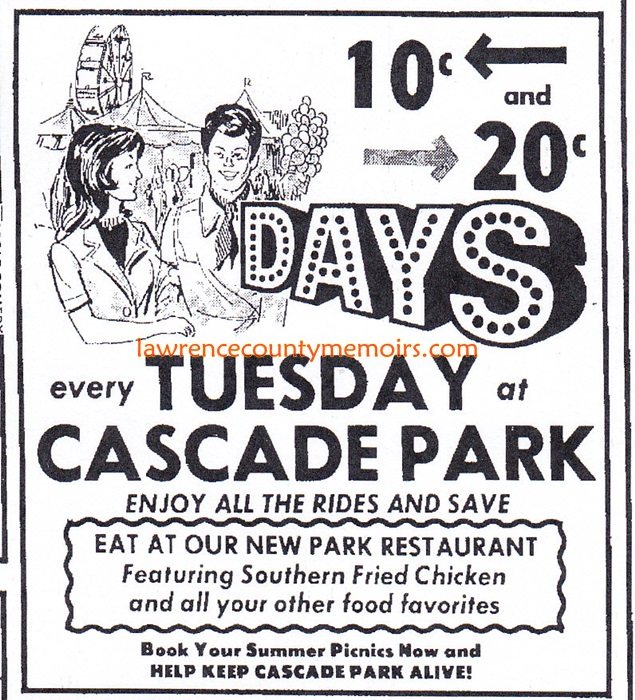 An advertisement from July 1972. |
 The station house for “The Comet” roller coaster. (c1982) |
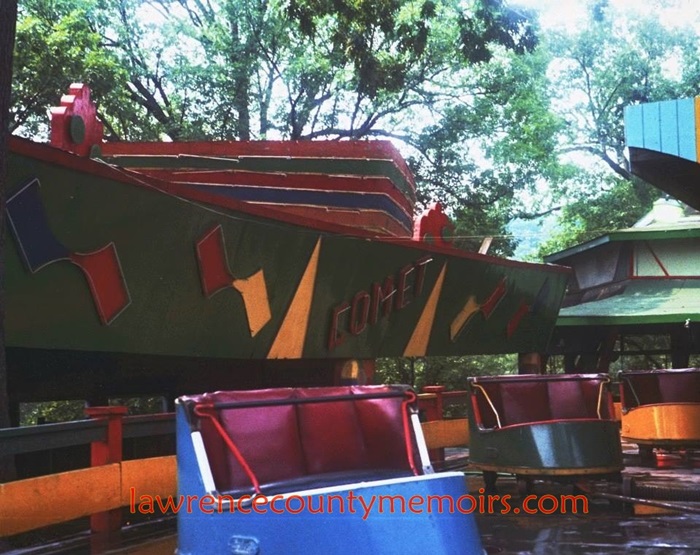 The cars of the Tumble Bug ride are seen here. (c1982) |
 (Jun 1976) |
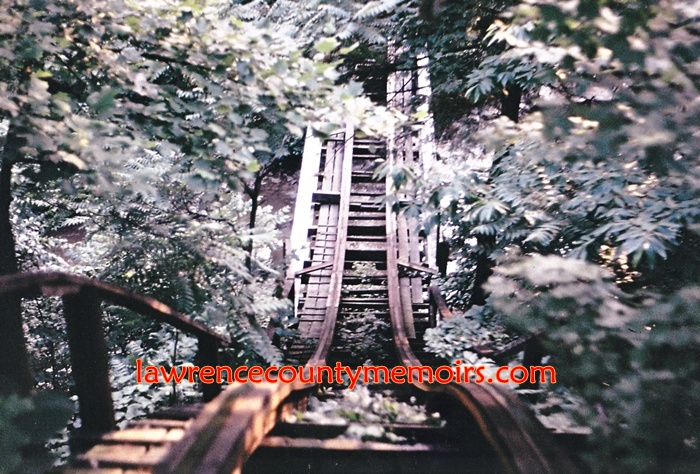 The Comet rollercoaster literally zipped through the trees! (c1980) Full Size |
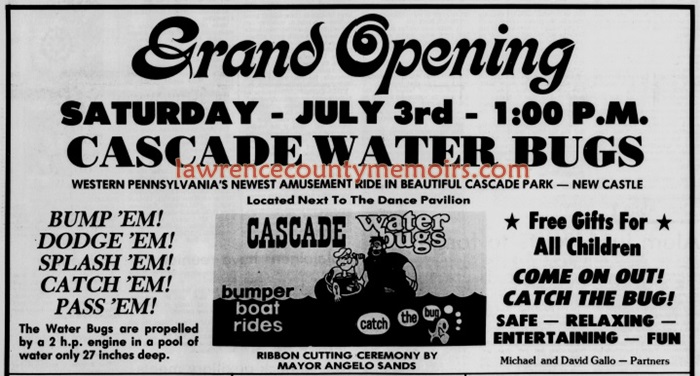 An advertisement announcing the opening of the Cascade Water Bugs amusement in the summer of 1982. (Jul 1982) |
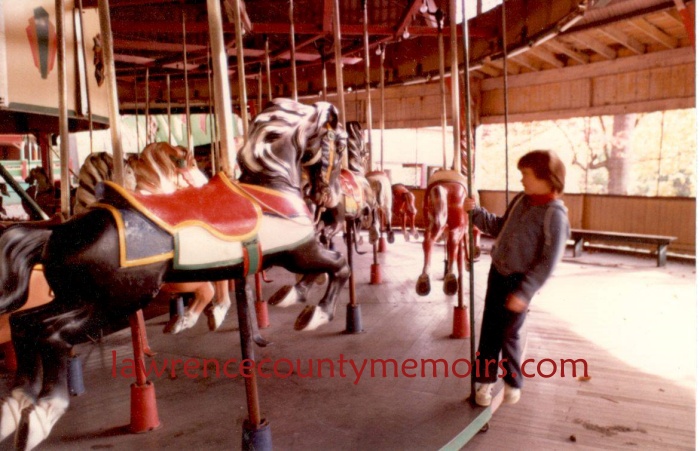 The soon-to-be abandoned carousel or merry-go-round at Cascade Park. (c1983) (Photo Courtesy of Tammy Walls Miller) |
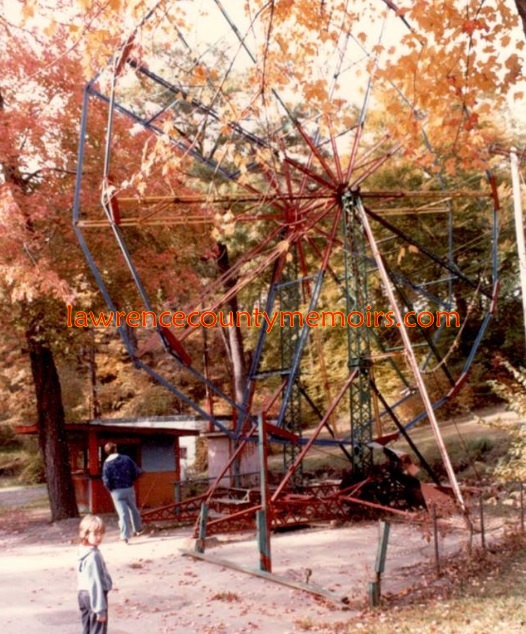 The old Ferris wheel at Cascade Park. (c1983)(Photo Courtesy of Tammy Walls Miller) |
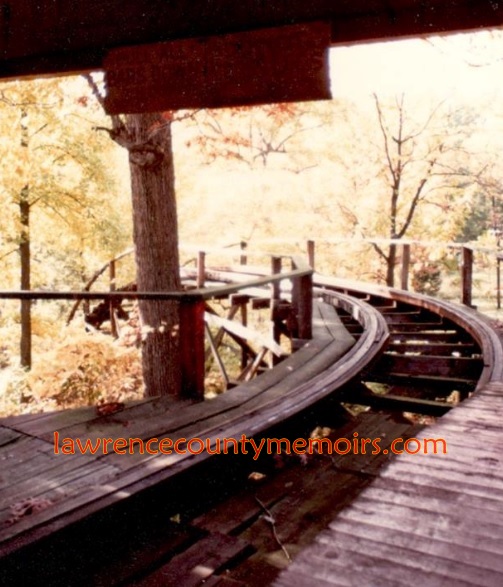 The view from inside the station house of the Comet roller coaster. From here the Comet dropped down almost immediately on its run around the park. (c1983) (Photo Courtesy of Tammy Walls Miller) |
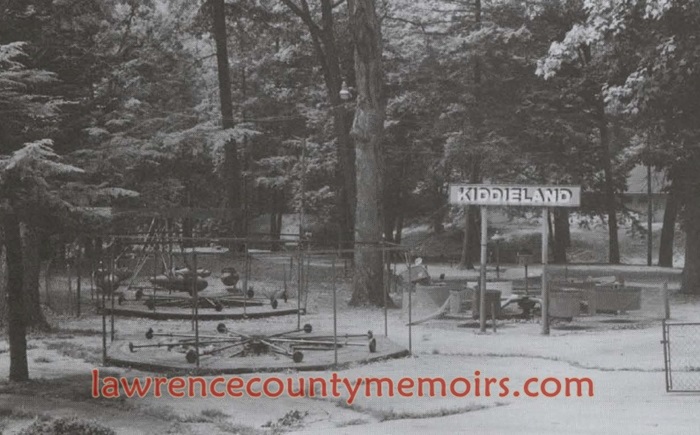 The major dismantling of the rides in the Kiddieland area took place beginning in early 1985. The rides at Cascade Park last operated during the summer of 1982. (1984) |
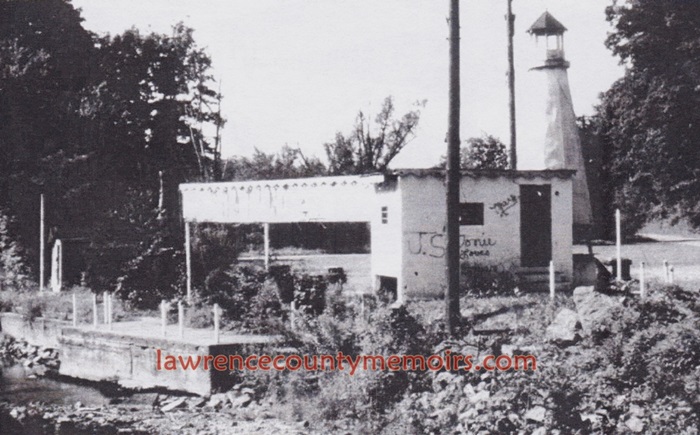 The boat launch area in a state of disrepair. A section of the old dam on Big Run collapsed on June 9, 1981, and the entire lake was drained as a result. Plans were discussed to repair the dam, but it was later deemed too expensive. (c1985) Full Size |
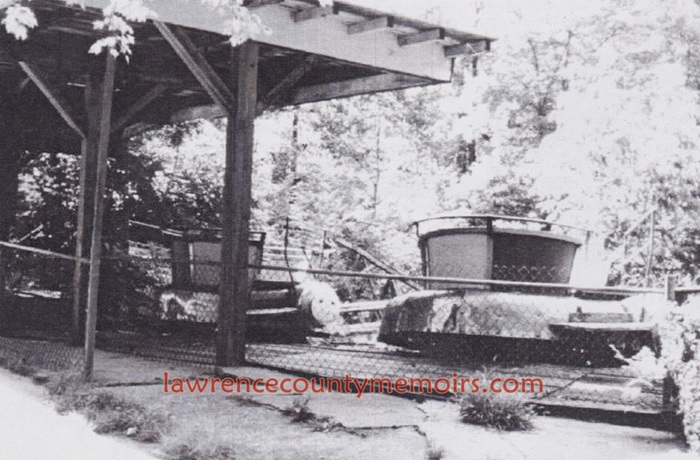 The old Tumble Bug ride a couple of years after it was abandoned. Paul Vesco, in the midst of a legal battle with the City of New Castle, began removing and scrapping most of the amusement rides in July 1985. (c1985) Full Size |
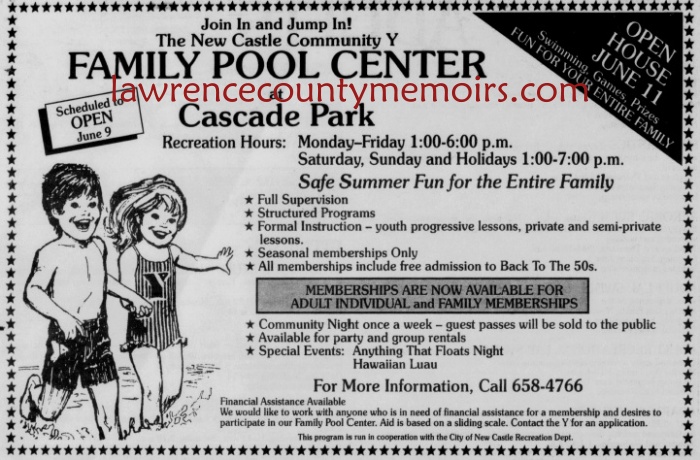 (May 1993) |
 The cars that once belonged to “The Comet” roller coaster sat abandoned along Moravia Street in New Castle for many years. I believe they were scrapped in about 2012. (c2007) |
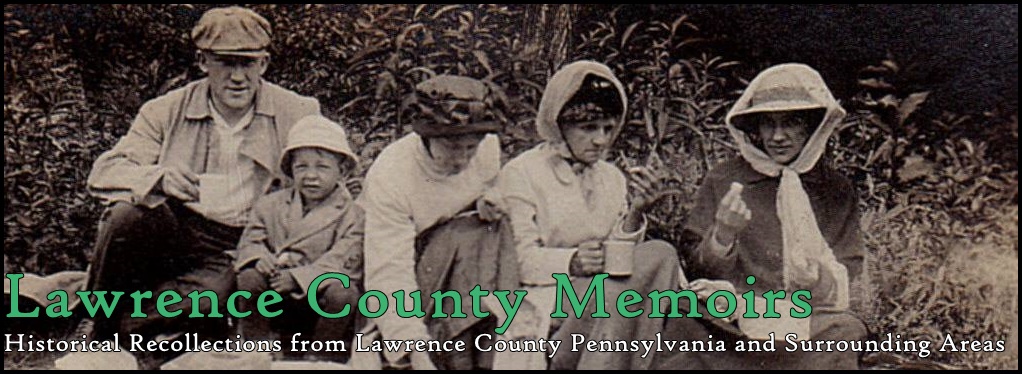




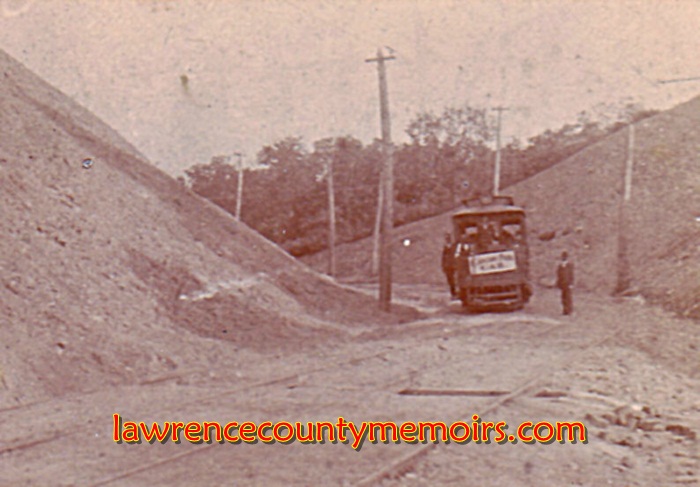


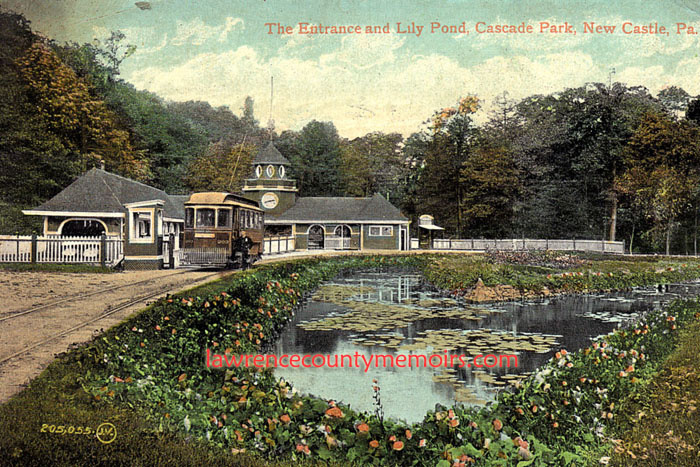
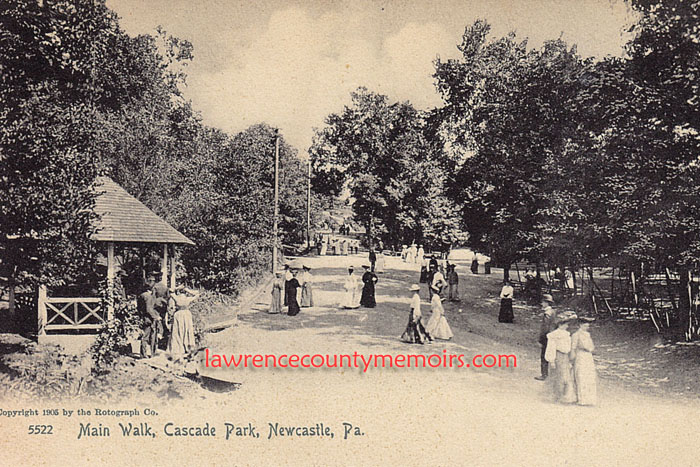
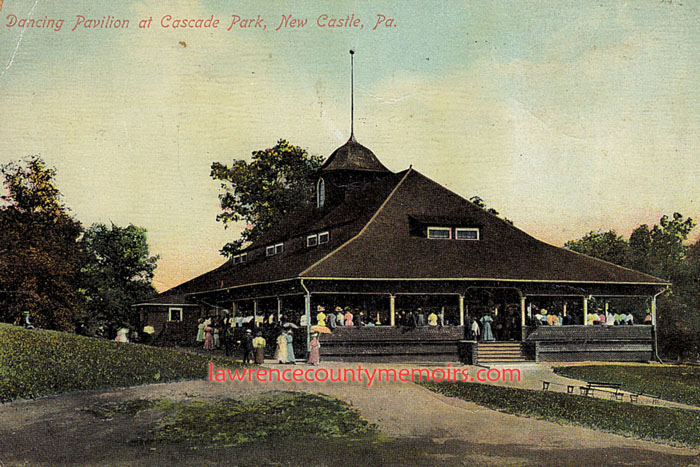
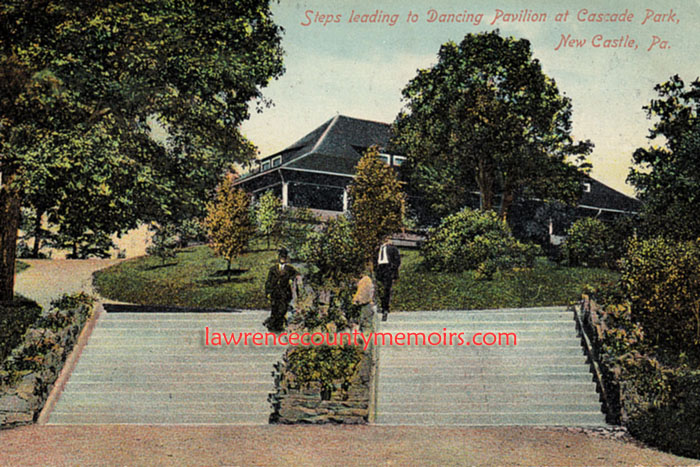
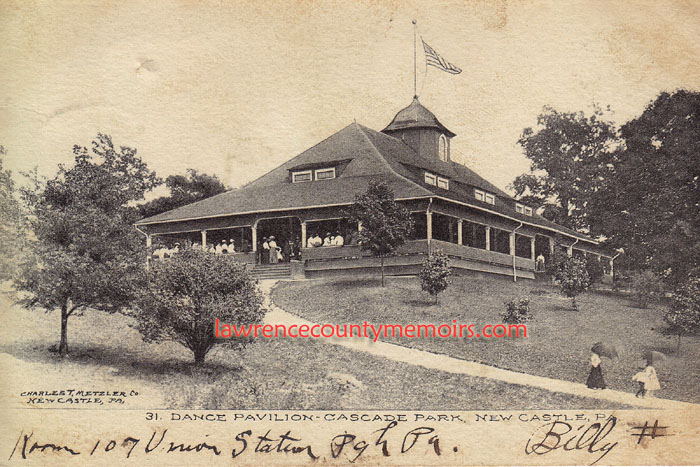
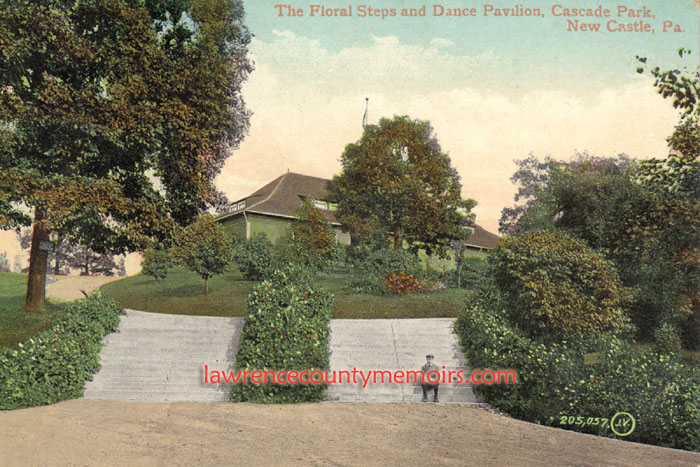

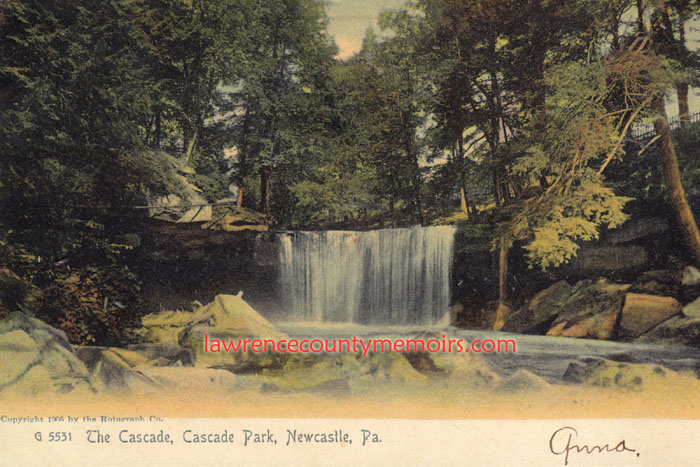
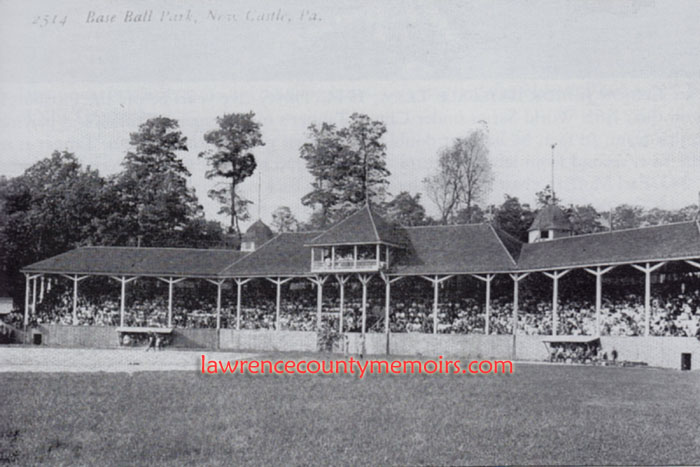
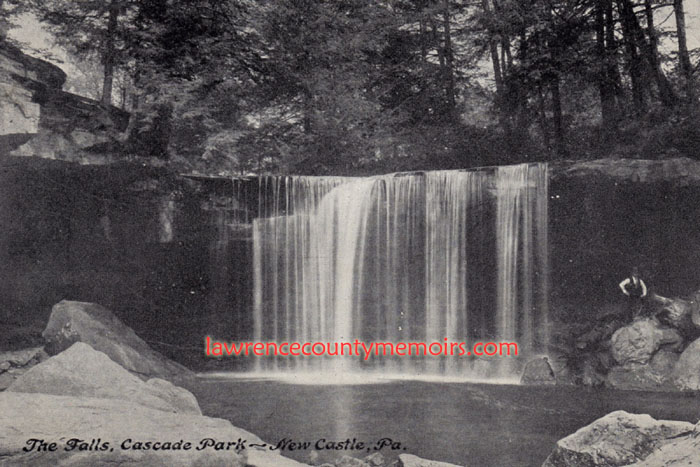

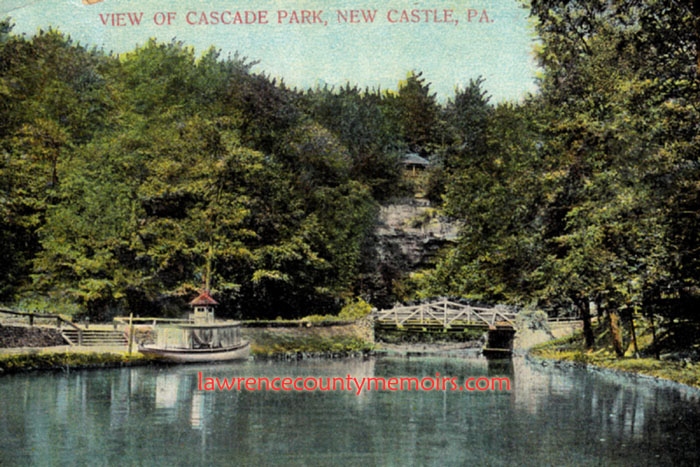



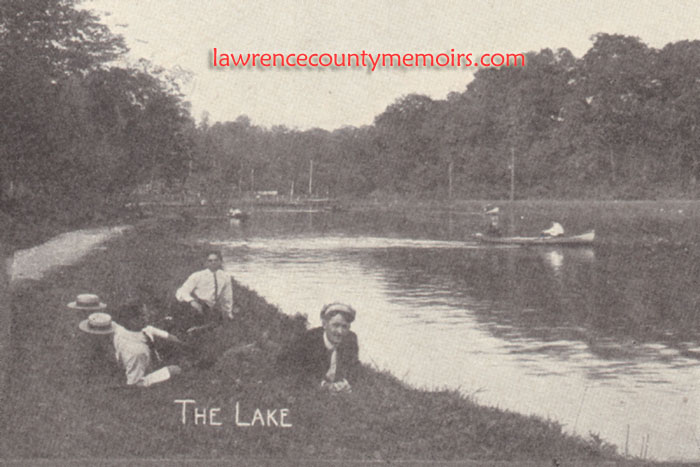

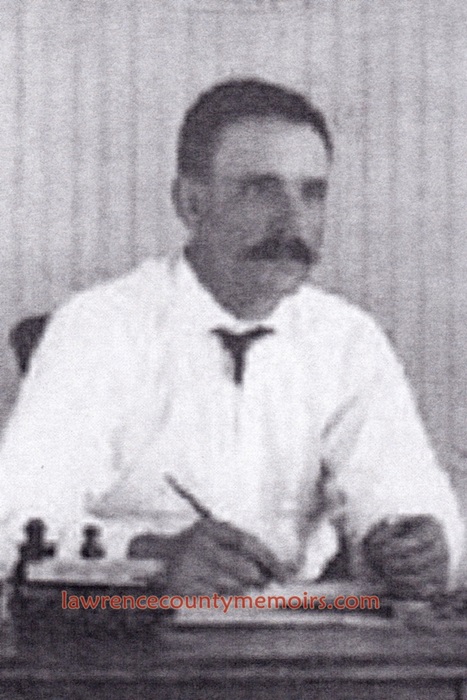
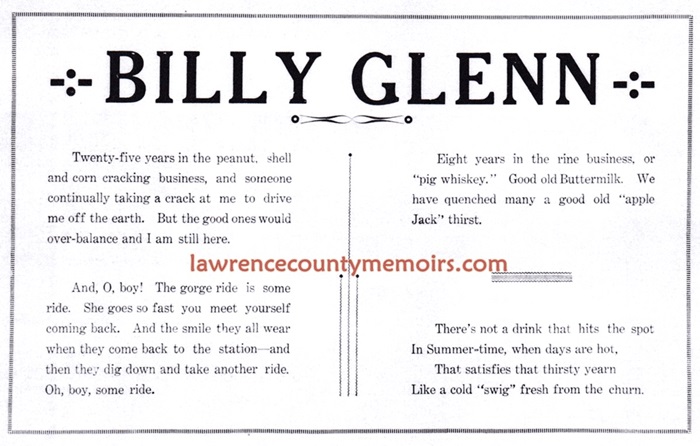

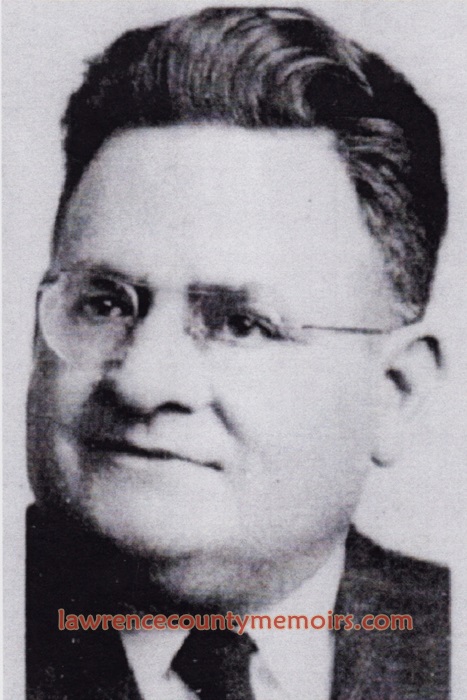
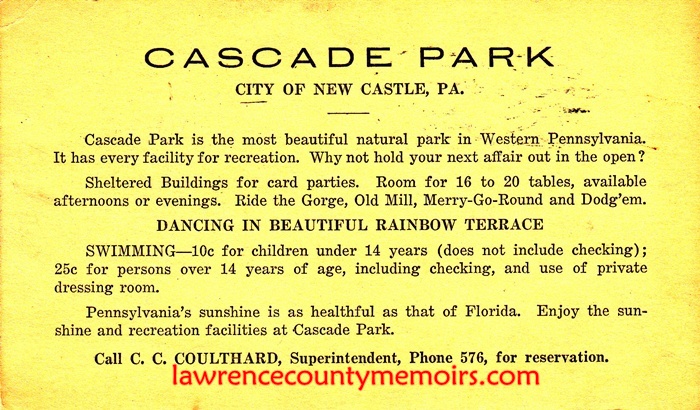

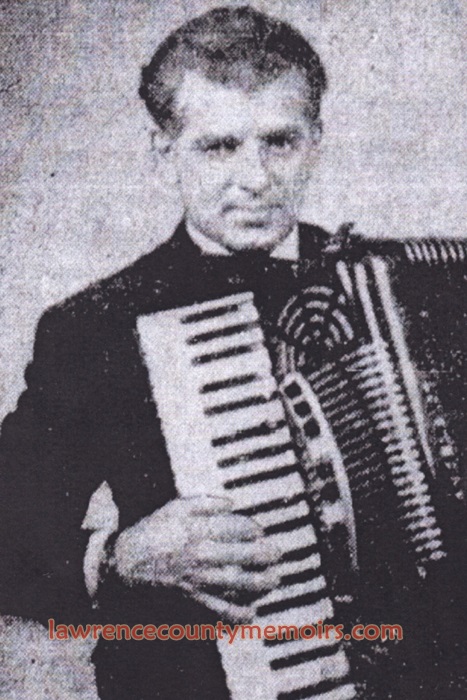



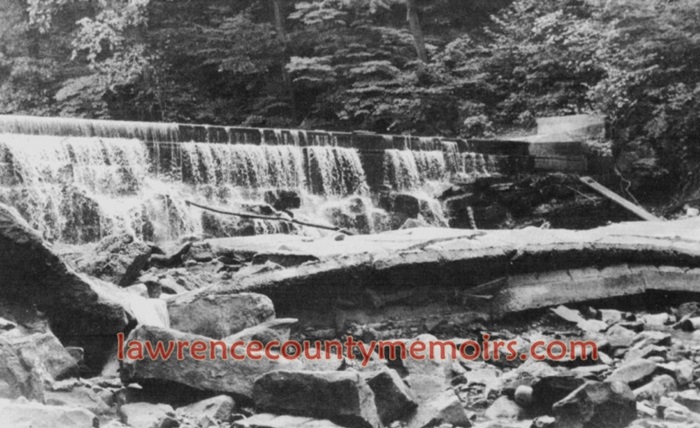
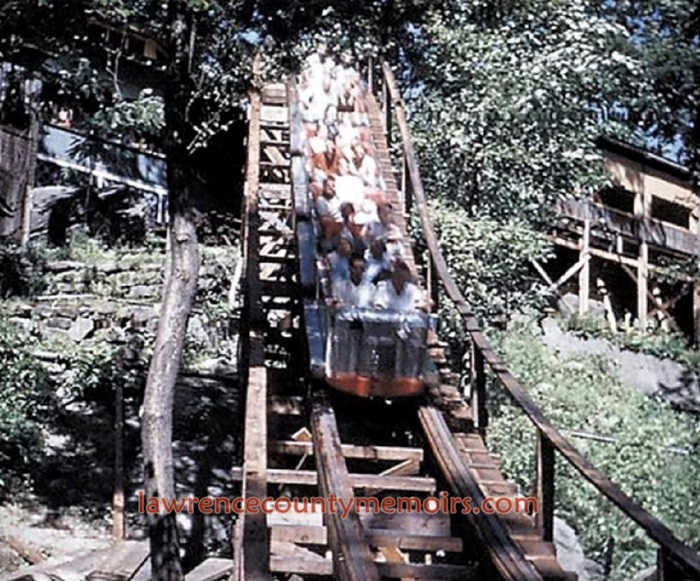
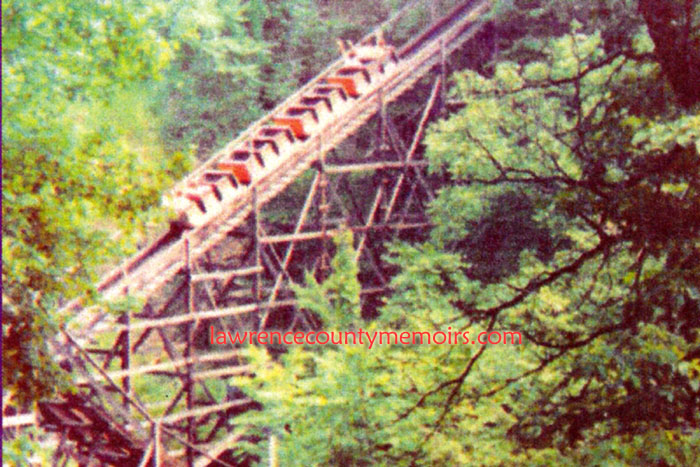
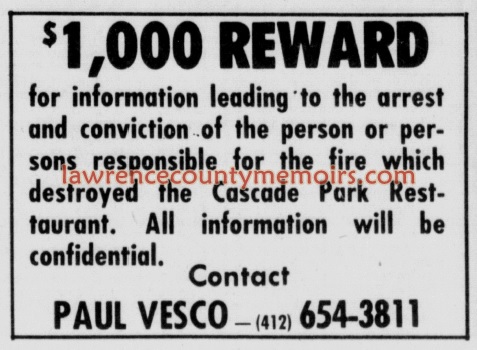
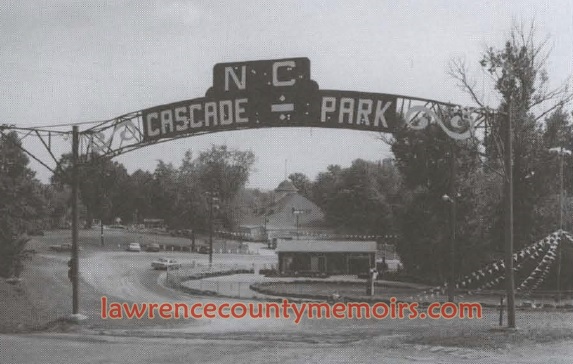
Comments
Sally Hanna Painter #
this brings back a lot of memories. I lived in Deshon Annex (converted barracks) and had to walk thru Cascade Park to get to my house.
Chris Gilboy #
Hi. I am Amy Mallik’s aunt. My cousin has a photograph of her grandfather, who was a carpenter, working on, I think, the merry-go-round building. I will try to arrange to have her let me have it to copy or get a photocopy of it. His name was Patrick McCormick.
patricia smith mahan #
I live on s mill St. I can remember my first ride my father took me on the merry go round what happened to the merry go round ? we always walked to casade park (5 curves, 1mile) in later years to swim in the pool.
Jeff Bales Jr #
(EDITOR’S NOTE) Patricia, thanks so much for your comment. The original carousel at Cascade Park was built in 1897, and was replaced with another one brought over from Idora Park in Youngstown in 1922. At that time a carousel house was also built near the dance pavilion to house the new carousel. The carousel was rebuilt in c1953 as the old wooden horses were replaced with aluminum ones. I have heard that after the rides were closed down in the early 1980’s the aluminum horses from the merry go round were stolen. Like many of the other rides I’m guessing the metal structure/parts of the merry go round were probably scrapped. The carousel house was left intact, and was fully restored and completed by 1991. Long live Cascade Park! Jeff
Robert Willims #
Hi Iam located in Ca.
My wifes grandfather was born in a cabin in cascade park in 1874 His name was Henry Bert
Do you know of any records that was kept at that time?? I am looking for his mothers name.
Could you possible point me in the right direction to obtain any info.
thank you Robert Williams
Mike Bruening #
Thanks for the picture tour Jeff! It was such an amazing park in it’s day. I worked there the summer of 1969 running the Tumble Bug (same as your father lol). The lake dam was still intact and one of the paddle boats was still afloat. Fabulous memories, even if we were only paid 70 cents an hour :)
Kathy Giddings McDowell #
I have good memories as a young child and teenager ofcascade park. My father worked for Penn Power in the 30’s 40’s and 50’s and they had co. Picnics there every summer. What memories I have! As a teenager swimming with a group of friends a couple times a week was a sweet treat. The frozen Milky Way bars ,I will. Never forget. I could go on and on. Loved the tumblebugs and swings etc. but not the gorge. Was not a fan of roller coasters. Loved everything about the park though and I am glad it was there when I. Was growing up. Thanks for the memories.
Michelle Galusha #
Wow, Just finished looking at all the pictures of the park. While I only have memories of the park during the 60’s, My mother remembers going to dances at the pavilion. My memories were mostly of the rides and the swimming pool. The last day of school was anticipated not only because school was out for the summer, but because we all met up at Cascade Park after lunch, for a time of celebration and rides. I think my parents gave my brother and I $5 for the afternoon. It was amazing how far I could stretch the $5. I always saved enough money to buy an Italian lemon Ice for on the drive home.
Lorraine Denison #
I worked at the pool as a basket girl in 1961 and I have fond memories of the Park…Rode the roller coaster 1 time and that was enough for me,,,Love the Italian lemon ice and the French Fri stand…and the tumble bug…
Janet Currie #
During the late 60’s and early 70’s there used to be “Park Dances”. Everyone would go to the dance and then sooner or later go down for a boat ride on the lake. On the 4th of July there were always fireworks at the lake.
Cristina Perry Icely #
You have done such a great job capturing the nostalgic beauty of this park. So many great memories in the 60’s and early 70’s. Thank you for the journey back to my childhood.
janet quimby #
I believe at least one of mr. vesco’s children is still living in new castle at this time. a woman i used to work with. I wonder if she would have any other pictures or stories of cascade park?
john m. #
I wonder if anybody could put me in contact with whoever bought the dodgem cars or tell me what happen to them
Thank you, John
Samuel Francazio #
Thanks for sharing you Archives, I had a Great time in my Playground down the street from my house on Temple Ave. Everything about the Cascade Park , the Rides,Swimming,Lemon-ice,Games,was like yesterday good memories ect. S.F
Arnold Edward Fraser #
One of my first summer jobs was there working at the “Tubble Bug” coaster. and later as a lifeguard 1956 – 58. In the younger days we would hop a train and jump off when it got to the Park. Then we would go under the falls and explore the caves under there. Then in high school all the dances there – swing lobby, etc. And, finally, Augustines pizza just opposite the entrance topped the evning off.
Jimmy Mike #
Seeing these old pictures was great. Melba and Paulie, I know you have a lot more pictures of the park. I worked at the park the summers of 1969 and 70. I operated the dodge cars, and drove the train. Even hit a police car with the train. I’ll never forget cascade park.
Judy Miller #
Boy did these bring back the memories. My dad and I used to ride the Comet everytime we went there….he insisted on it. That was his favorite ride and mine too…..good times !!
Vince Sanfilippo #
I can hear my Father (Joseph C Sanfilippo, deceased) telling stories of when he was a young boy, cutting potatoes at the french fry stand. My Grandmother, Nellie (Zazarino) Sanfilippo used to sell French fries out of that stand…………….and yes they came in a paper cone and the vinegar bottle sat right on the counter. Best fries in the world! Time frame would have been late 40s and early 50s….I’m guessing.
Pat Wargo #
Brings back so many memories. Our Family Reunions were always here, and started with breakfast at 8:00 AM, and ended with the family games late at night. The kids all went swimming and rode the rides. It was a great place for family gatherings.
J Mason #
I worked in the park for Paul Vesco in 72 and 73. I lived pretty close on Huron avenue and used to walk down to the lake often to go fishing. The damn was broken, but still held water in the lake. The boat house was still working and occasionally we would rent a rowboat and go out on the lake. My friend and I actually ran a trap line down the backside of the lake near the RR tracks and down the creek below the damn for a couple miles. On the way home from fishing we would stop along the path and pick blackberries and raspberries that grew wild there. I had heard that Mr. Vesco had sold the merry-go-round when the park was closed. I never heard the rumors that the horses were stolen. I also remember long days at the public pool and stopping to get French fries loaded with salt and vinegar on my walk home.
virginia reider #
loved cascade park. loved the dodge em great French fries, swimming roller coaste My sisterand I used to go there and walk around. Many merories
C. Cwynar #
Do you know anything about the man who lived in the house under the roller coaster? And why there was a house under the roller coaster, ha! This is a story I heard and found it very interesting. Thanks
EUGENE HOOVER #
MY FATHERS COMPANY PICNICS WERE AT THE PARK LOTS OF FUN THE HOTDOGS AND FRENCHFRIES AND THE RIDES
Alilly Greco #
Wow! You really put a lot of time and effort into this! It’s a great and very informative read, thank you so much!
David Denny #
I spent a couple of days a week during the summers from 1960 to about 1967 out at the park. We lived on Court St and we would ride our bicycles out to go swimming in the pool or swim in the lake if we didn’t have any money. My dad worked for Conn Welding and would get free tickets a couple of weekends each year so I got to ride the Carousel and later the Comet. Also rode on the riverboat when it was new. The Riley family owned the Miniature golf course and Tommy Riley was in my class so we used to get in for free occasionally. Paul Vesco was my music teacher for a few months in the early 60’s. A bag of fresh roasted peanuts was a nickel and another 5 cents would get you a cone of fries and I still use vinegar on my French fries to this day.
Audrey Geer #
I really enjoyed this article on Cascade Park. It is well researched history. I have many childhood memories there. Thank you!
Laurie Gauntner #
Grew up attending my Dad’s Ellwood City Forge picnics at Cascade. I have the best memories of the coaster and how it headed down into the ravine! My dad claimed he took me on that coaster when I was only two, but I have no idea if he was kidding or not. Around the age of 12, I took a great leap from my carousel horse and grabbed a “brass” ring. Unfortunately, someone had to come lower me to the ground, because they weren’t the kind of rings I’d read about In books! Still, I obviously have wonderful memories of the park.
Jeff Bishop #
I have a water color of the Fun House at Cascade Park, painted in 1938 by a fairly well-known local artist, Fred Alexander.
Doesn’t look anything at all like what I remember from the 1960’s, when we would go there for the Rockwell Company picnics.
Spent most of my life in the New Castle area, now in Maine, but still have family there.
George Houston #
I was lucky enough to be a lifeguard the final year of the old pool and the following year when the new pool opened. I also have wonderful memories of the french fry stand that had the fries in the paper cone and the aluminum salt shaker and malt vinegar. The best fries I ever ate. I also recall riding on the firetruck as a young child and kiddie land too. I ice skated on the lake with my high school sweetheart in 1976 or so. Great memories of the park, thanks so much for your effort in researching and writing the article.
Ron Murphy #
I could swear that the picture of the Gorge dated 1930 is a picture of the newer coaster in the 1950s and was installed under the work of Paul Vesco,
Jerry Ascione #
There is a picture listed of “A Polka Band in Action.” I’m pretty sure the clarinet player is my father. Armand Ascione. I know who the other band members are. That was a great band.
Sam Makarevich #
I grew up with Cascade Park as part of my childhood (child of the 60s) and even visited last weekend.
What I want to know is, where are the movies of Cascade Park? There has to be some movie footage somewhere that people can share.
John Jessel #
The swimming pools were great fun, but I never enjoyed getting to them from the changing rooms. The trip involved walking down a tunnel-like staircase toward a footbath that had to be crossed before reaching the pool areas. I believe I was told that the ankle-deep water was treated with a medicine that would attack athlete’s foot. But its cold and milky water was made even more unattractive by the candy bar wrappers and other debris floating atop the chemical-scented concoction. It was a blessing to step from it into the sunshine-warmed concrete that paved the poolside areas.
Sherry Slater #
Jeff,
The picture of the coaster I sent you was from 1903 and was of the first roller coaster. I have a few more pictures that were taken at the same time of the area that became the picnic grove. Before anything was there.Comment